#continuing onwards to baghdad
Explore tagged Tumblr posts
Photo
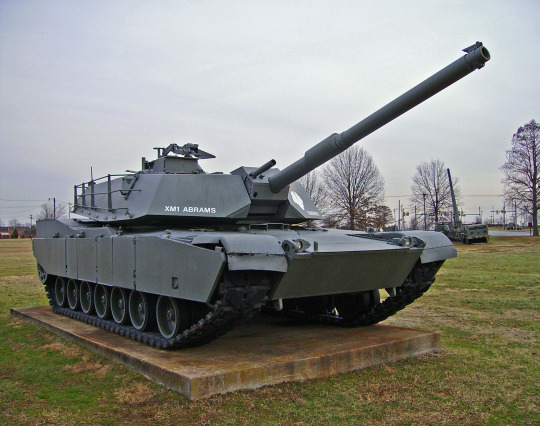
(via XM1 Abrams Main Battle Tank by DarkWizard83 on DeviantArt)
The original prototype vehicle that led to one of - if not the - most powerful tank in the world, and current backbone of Us armored forces, the M1 Abrams MBT. Born out of the failed German-American MBT-70 project, the XM1 was developed by the Chrysler Motor Corporation, and in 1978 Chrysler delivered to the Army a sleek, low-silhouette heavy tank that incorporated every major technological feature of the day, including computerized controls and a laser rangefinder. But the most significant design feature of the new tank was its use of Chobham composite armor on the hull and turret. While the exact nature and composition of Chobham armor remains a closely guarded secret, the evidence suggests that it utilizes a matrix of ceramic armor tiles, layered between the vehicle's internal steel and external armored plating. When a high-velocity projectile - such as a round fired from a tank or an anti-tank missile - hits the armor, the explosion produces a high-velocity jet of gas that shears through the armor plating. In normal armor, this jet of gas - once it had passed through the outer armor - would blast into the hull of the tank, causing irreprible damage and often killing the crewmen inside. However, with Chobham armor's interweaved layers of ceramic composite, the forces that would normally tear into a tank's hull are forced to spread out and dissipate over a much wider area, leaving the inner hull intact. This not to say that Chobham armor renders a tank invincible - any hit will still cause exterior damage, and a powerfiul direct hit could still damage or disable the tracks or sensitive electronic equipment. But it would keep the crew alive, and often protect the tank itself enough to keep fighting. Another key crew safety feature is the vault-like armored compartment that houses the Abrams' primary ammunition. One of the primary causes of a tank's destruction has not been the direct result of armor-pierecing hits, but the inderict results of those hits ignigting and detonating the tank's munitions. To protect this, a kevlar and steel armored plate seperates the crew from the ammunition store. Same with the tank's fuel supply. Even if the compartments were pierced, and the ammunition or fuel ignited, the protective plates would insulate the crew from explosion and fire. In combat, the Abrams has proven to be second to none. During Operation Desert Storm in 1991, M1s were able to take out Iraqi tanks at distances as long as 4km. Of the nearly 2,000 Abrams to see combat in the conflict, only 18 were ever taken out of service due to combat damage, and none resulted in any crew casulties. In 2003 and onwards during Operation Iraqi Freedom, the Abrams again demonstrated a mastery of the battlefield, driving to Baghdad virtually unopposed. However, the Abrams clearly showed its vulnerability to ambush attacks, with a number of M1s severly damaged and disabled from RPGs, and far more frequently by roadside IED bomb traps. However, even when caught in some of the largest IED explosions, crew casualties have so far been astoundingly low, a testament to the M1s protection and survivability. While no future M1's are planned for production, a number of older models are currently slated for upgrade to current standards over the next few years, and the Abrams will continue to serve with the Us Army and Marine Corps. for mcuh of the century to come. M1 Abrams Vehicle Stats: Type: Main battle tank Manufacturer: General Dynamics Land Systems First deployed: 1980 Crew: 4 Length: 9.76 m Width: 3.65 m Height: 2.88 m Weight: 61.4 tons Armor: Classified Armament, primary: 1 x 105mm M68 rifled tank gun; later models equipped with 120mm M256 smoothbore tank gun Armament, secondary: 2 x 7.62mm FN-Browning M240 machineguns, 1 x .50-cal Browning M2 BMG machinegun Ammo stowage, primary: 55 rounds Ammo stowage, secondary: 11,000 rounds 7.62mm, 1,000 rounds .50-cal Powerplant: Textron Lycoming AGT1500 1,500hp gas-turbine engine Max speed: 72 km/h Max range: 498km Operators: Australia, Egypt, Kuwait, Saudi Arabia, USA
14 notes
·
View notes
Text
Baghdad gone wrong - Request
Request: @green-spotlight I was wondering if you could do a Sherlock x wife! reader one? Where, instead of Mary jumping in front of Sherlock, Reader does, but she survives
Word count: No idea, but it’s long.
Warnings: (Y/N) gets shot.
A/N: HI! Long time no see. I know I always say I’ll come back and then I disappear but it’s just because I need a job and I have to look for it and bla bla bla. Anyway, here it is. This one is fresh, it’s the first fics I’ve written in months (the past ones were kept in my drafts) so I hope you like it and I hope I’m not too rusty for this.
Enjoy!

The London aquarium was quite a flabbergasting experience to anyone who visited. The big tanks filled with different fish, the blue illumination, and the distinctive smell of chlorine made it a rather peaceful place to meditate.
“Ladies and gentlemen, the Aquarium will be closing in five minutes. Please make your way to the exit. Thank you.” The voice from the tannoy announced.
Sherlock ignored it and kept going onward along the blue-lit corridors, through the glass tunnels, up until an area with benches for people to sit. There, a lonely woman sat tranquilly.
“Your office said I’d find you here,” he said.
“This was always my favourite spot for agents to meet,” the woman replied. “We’re like them; ghostly, living in the shadows.”
She finally looked at him.
“Predatory,” Sherlock granted.
“Well, it depends which side you’re on.” She turned away to look into the shark thank again. “Also, we have to keep moving or we die.”
“Nice location for the final act. Couldn’t have chosen it better myself. But then I never could resist a touch of the dramatic.” Sherlock cocked his eyebrow, rejoicing in his own skin.
“I just come here to look at the fish,” the secretary said.
How dull she was, how boring. Sherlock was starting to get sick just by the mere existence of that woman. It was obvious to him what was going on, and yet there was no one else to show it off to. Where were his companions? He had texted them not longer than five minutes ago the exact location and they weren’t there just yet.
“I knew this would happen one day,” the secretary continued. She stood up and took a few steps closer to the tank. “It’s like that old story,” she said. She turned to face him.
She was small, just small. She was not a beautiful woman and evidently never had been, she was poorly-dressed, and her whole body expressed how small she was and felt.
It was no wonder to Sherlock why she had done it. She was a nobody, always had been and always would be. She worked for a powerful, beautiful woman who was a constant reminder of how insignificant she was. Of course, she had done it.
“I am a very busy man. Would you mind cutting to the chase?” Sherlock insisted. A rush inside of him needed the whole thing to end quickly.
“You’re very sure of yourself, aren’t you?”
“With good reason,” Sherlock said precisely. “Unlike you,” he thought.
“There was once a merchant in fa famous market in Baghdad…” The woman started.
Sherlock closed his eyes and lowered his head. It was that bloody story again. What was it with people liking it? Perhaps it was the fact that nobody wants to be entirely responsible for their acts and decide to call them upon fate, or just that dumb believing of superior power. In any case, Sherlock was sick of it.
“I really have never liked this story” he sentenced.
“I’m just like the merchant in the story. I thought I could outrun the inevitable. I’ve always been looking over my shoulder; always expecting to see the grim figure of…”
“Death.” A third voice completed.
(Y/N).
The rush inside Sherlock increased its intensity. She wasn’t supposed to be there, John and Mary were but not her.
She entered the room and stopped a couple of feet away from Sherlock’s side.
“Hello, love,” Sherlock greeted without looking at her.
“Hey,” she greeted back.
“John?”
“On his way,” (Y/N) replied.
“Mary?”
“On her way.” Sherlock shrugged and attempted no to look scattered. She was not supposed to be there. “Who am I looking at?”
“Let me introduce Amo.”
(Y/N) opened her eyes widely. She knew all about that time, Mary had told her just before escaping to try and fix things.
“I can’t say I’m impressed,” (Y/N) said. Sherlock chuckled at the thought of how obvious it was, feeling good that his partner had caught it too. “So you were Amo? You were that voice on the phone?”
“Using AGRA as her private assassination unit,” Sherlock completed.
“Why did you betray them?” (Y/N) grunted. She could be too emotional sometimes. “Do you know what you caused? The people you hurt? Do you know how that ended? WHY DID YOU BETRAY THEM?”
“Why does anyone do anything?” The secretary asked, knowing well what she had done. She didn’t seem to regret a single thing.
(Y/N) was fuming, Sherlock could hear her breathing and was getting ready to stop her in case she tried to punch the secretary.
“Let me guess,” he said in an attempt to control the room. “Selling secrets?”
“Well, it would be churlish to refuse,” the secretary admitted and Sherlock couldn’t blame her. “Worked very well for a few years. I bought a nice cottage in Cornwall on the back of it. But the ambassador in Tbilisi found out. I thought I’d had it.” She looked towards (Y/N) before returning her gaze to Sherlock. “Then she was taken hostage in that coup,” she laughed. “I couldn’t believe my luck! That bought me a little time.”
“But then you found out your boss had sent AGRA in,” Sherlock stated. He finally had an audience to show off with.
“Very handy,” the woman replied in a bitter tone. “They were always such reliable killers.”
“What you didn’t know, (Y/N), was that this one also tipped off the hostage-takers,” Sherlock explained to (Y/N). “Actually,” he said, “I don’t think Mary knows that either.”
The secretary sat back down and rested her handbag on her lap.
“Lady Smallwood gave the order, but I sent another one to the terrorists with a nice little clue about her code name should anyone have an enquiring mind.” She was proud of her doings. “Seemed to do the trick!”
“And you thought your troubles were over.” (Y/N) was furious.
“I was tired; tired of the mess of it all,” she sighed. “I just wanted some peace, some clarity.”
(Y/N) was about to go on and punch the light out of her, but Sherlock stopped her before she had even given two steps forward.
“The hostages were killed, AGRA too…” She looked across to (Y/N), “or so I thought. My secret was safe. But apparently not. Just a little peace. That’s all your friend wanted too, wasn’t it? A family, home. Really, I understand.”
(Y/N) glanced across to Sherlock, but his gaze was fixed on the secretary who lifted her handbag as if in preparation to stand, and rests one hand on the open top of it.
“So just let me get out of here, right? Let me just walk away. I’ll vanish. I’ll go forever. What d’you say?”
“After what you did?!” (Y/N) roared furiously. She once again started walking towards the woman.
“(Y/N), no!” Sherlock yelled. That’s why he didn’t take her to her cases.
In a fluid moment, the secretary stood up, pulling a pistol from her handbag and aiming it at (Y/N), who stopped and backed away.
(Y/N) considered her options for a second before obliging. “Okay.” She moved back to stand at the other side of Sherlock.
The secretary stopped pointing with her pistol and looked at it as if it was a toy.
“I was never a field agent. I always thought I’d be rather good.”
(Y/N) scoffed. She was upset and she knew they were wasting their time by trying to reason with her. She never understood why Sherlock insisted on talking to the criminals first.
“Well, you handled the operation in Tbilisi very well,” Sherlock complimented and (Y/N) rolled her eyes.
“Thanks.”
“For a secretary.”
(Y/N) and the secretary looked at him with wide eyes.
“What?” The woman frowned.
“Can’t have been easy all those years, sitting in the back, keeping your mouth shut when you knew you were cleverer than most of the people in the room,” he blurted out.
“I didn’t do this out of jealousy!” She defended herself.
“No?” Sherlock smirked. “Same old drudge, day in day out, never getting out there where all the excitement was. Just back to your little flat on Wigmore Street.”
The secretary gaped.
“They’ve taken up the pavement outside the Post Office there. The local clay on your shoes is very distinctive.”
The woman looked down to her dusty shoes. She looked like a rag, no wonder why he thought she was jealous.
“Yes, your little flat.”
“How do you know?”
Sherlock was ready for a quickfire session to kill time and show off to the woman he married. He cocked his head and smirked as if he had already won.
“Well, on your salary it would have to be modest and you spent all the money on that cottage, didn’t you? And what are you? Widowed or divorced?” He focused in on a plain gold band on the index finger of her left hand. “Wedding ring’s at least thirty years old and you’ve moved it to another finger. That means you’re sentimentally attached to it but you’re not still married. I favour widowed, given the number of cats you shared your life with.”
(Y/N) watched the woman closely. She knew that look, that void of fear, that confidence. The woman wasn’t shaking, nor she was feeling vulnerable. No, she was starting to burn in anger. She was a crazy woman who thought she was better than anyone else, of course, she would burn if anyone told her she was anything less than that.
She hadn’t done it out of jealousy, she had done it because she could.
“Sherlock…” (Y/N) warned.
“Two Burmese and a tortoiseshell, judging by the cat hairs on your cardigan,” Sherlock continued. “A divorcee’s more likely to look for a new partner; a widow to fill the void left by her dead husband.”
“Sherlock, don’t,” (Y/N) insisted with a louder tone.
But instead of listening, Sherlock rose his voice ad he got fully into his stride. “Pets do that, or so I’m told, and there’s clearly no-one new in your life, otherwise you wouldn’t be spending your Friday nights in an aquarium. That probably accounts for the drinking problem too: the slight tremor in your hand… The red wine stain ghosting your top lip. So yes. I say jealousy was your motive after all - to prove how good you are...”
The secretary turned to gaze at the entrance as Mycroft walked in.
“... To make up for the inadequacies of your little life.”
The secretary was still looking at the entrance. Inspector Lestrade came in followed by three uniformed police officers.
“Well, Mrs Norbury. I must admit this is unexpected,” Mycroft said, hiding away his true feelings.
“Vivian Norbury, who outsmarted them all,” Sherlock slurred, dripping in sarcasm. “All except Sherlock Holmes.”
He took a step forward, holding out his left hand. (Y/N) and the police officers behind her also stepped forward.
“There’s no way out,” he whispered.
“So it would seem,” Mrs Norbury smiled. “You’ve seen right through me, Mr Holmes.”
“It’s what I do.”
She tilted her head to one side. “Maybe I can still surprise you.”
Swiftly, she brought up the gun and aimed it at Sherlock. Everyone got defensive instantly.
“C’mon,” Lestrade pointed at her, “be sensible.”
Sherlock held his hands out to the side. Mrs Norbury shook her head.
“No, I don’t think so.”
She fired. The bullet headed towards Sherlock who stood there unmoving. (Y/N), who had no doubt anticipated that this was going to happen, hurled herself sideways in front of him and the bullet impacted her lower chest. Blood sprayed outward and immediately there was a large bloodstain on her shirt. Crying out, she fell to the floor against a nearby bench.
“Surprise,” Mrs Norbury said, filled with spite.
(Y/N) rolled over to slump against the back of the bench, gasping in pain. As two of the police officers hurried over to Mrs Norbury to disarm her, Sherlock stared at (Y/N) in shock, then dropped to his knees to press his gloved hand against the wound. She looked up at him, her eyes wide, and whimpered.
“Everything’s fine. It’s gonna be okay,” he whispered. “Get an ambulance!” He commanded, looking round to Mycroft.
“You are such a cock,” (Y/N) whimpered.
“I know,” Sherlock smiled sadly. “But now, dare I say it, it’s not about me.”
“What do I do now, detective?”
Sherlock started checking her frantically just as John ran in. Without asking any questions, he checked her too and laid her down on the floor.
“It’s all right,” Sherlock kept saying, “it’s all right.”
“You can do better than that,” (Y/N) groaned and John kept track of her vitals.
“Like what?”
“Like what about you shut up next time?” Sherlock chuckled and nodded.
“Noted,” he said. “Anything else?”
“If I don’t die…” She started and Sherlock interrupted her.
“Which you won’t.”
“IF I DON’T DIE,” she insisted, “I want you to be more loving towards me.”
“What?” Sherlock frowned and John laughed. “No.”
“Oh, oh, I think I’m losing her,” John joked, “(Y/N), stay with us!”
“Okay, fine,” Sherlock agreed. “But only when we’re alone.”
“That’s not how it works,” John coughed.
“It is how it works!” Sherlock cried.
“It’s not!” Mary laughed and kneeled down next to (Y/N), helping John to keep her stable while the ambulance arrived.
“You two are too nosey,” Sherlock mumbled.
“Loving, you must be loving at all times or I’m going to die,” (Y/N) repeated. She was falling unconscious, so John and Mary urged Sherlock to keep her awake for just a couple of minutes now.
“Okay, what else?” Sherlock asked, “What else, (Y/N)?”
“Breakfast… in bed…” She mumbled.
“I already do that!”
“For me… breakfast in bed… for me,” (Y/N) insisted.
“You are such a cock” John mocked Sherlock.
“Yes, I’ve been told that twice in the last minute.”
Mary laughed and so the paramedics got there.
-
When (Y/N) woke up, she was surrounded by people. Mrs Hudson, Molly, John, Mary, and obviously Sherlock.
“We’re so glad you’re awake.”
“How are you feeling?”
“Look at you!”
All of them, talking to her nonstop. She only nodded and smiled, not knowing who to reply to first.
Her room was filled with flowers and balloons, and the dim light of midday snuck through the window, making it warm and cosy. She didn’t feel a thing because she was doped, but she faintly knew (by what she could catch hearing at least) that she had gone to surgery.
“I’m glad you’re awake and fine,” Sherlock said after everyone shut up.
“That’s all?” She complained.
John hit Sherlock slightly. The detective rolled his eyes and pulled out little cardboard cards from his pocket. He cleared his throat and started reading in a painfully monotone voice.
“My love, I am delighted for your recovery and I can’t wait for you to come back home to me. I’ve missed having you in my arms, smelling your hair in the morning, and just looking at your… bright, beautiful eyes every day. You are my soulmate, and the thought of losing you was so painful I knew right then and there that I… Nevermind that part, it’s bullshit,” he skipped three cards while everyone else either rolled their eyes or chuckled at him. “You are the love of my life… My best friends… Kiss, kiss, kiss… Er… The message is clear I think.”
“That’s all?” (Y/N) asked again.
Yes, she had technically forced him to date her, and then to marry her, and she had kind of manipulated him to promise her to be more loving, so she couldn’t really complain if he didn’t get it right the first twenty times, but she was the one laying on a hospital bed because he couldn’t get his head out of his own arse!
Sherlock exhaled heavily and looked around. Curious and impatient eyes were all over him, making feel terribly uncomfortable.
“The thought of losing you is unbearable, I was very anxious during your surgery and have been like that up until now that you’ve woken up,” he admitted.
“He also spent the night right here,” Mrs Hudson added. (Y/N) then noticed an unused blanket by the visitor’s sofa.
“Thank you, Mrs Hudson,” Sherlock groaned and gave (Y/N) a cheeky look. “I’m not good with words, but do know that I’d be damned if you, my wife, died.”
“How romantic!” (Y/N) smirked sarcastically. Sherlock eyed her, knowing she was just messing with him.
“I love you, I truly do.”
“And I love you,” (Y/N) said.
Sherlock then walked closer to her and kissed her softly on the lips. “Don’t ever follow me on a case, please.”
“I can’t promise you that.”
“Then don’t jump in front of me if I get shot.”
“Better you stop being a massive cock, ey?”
“I can’t promise that.” Sherlock smiled.
-
If you want and can support me buy me a coffee here or here too! You can also join my Patreon. It really does help me A LOT.
Masterlist
Requesting rules
Schedule
To-do list
TAGS!
Forever Tags: @myfriendmagislit @pureawesomeness001 @bingewatchingmylifegoby @cutie1365 @wonderwinchester
BBCitters Tags: @marietrevosa @coco96 @unwrittenletter
Sherlock Tags: @procrastinating-my-life-away @charlottemalfoy @just-a-blog00 @wefracturedmotivation @sugarshai-blog @roseyhxnt @foureyedsiopao @nicole-pierce @captain-sherlockomg @kissed-by-white-wolf @samanthasmileys @demonminnion3 @thatmoodindigo @sexyporntime-blog1 @neonpinkbeard @destiel5100-blog @peachyoshi64 @violenttgod @shadyladyperfection @thisisafanficblog-blog @marymaia00 @fanderrawr @lovelyblackdespair @thegameisafootwatson @imissyoualittlemoreeveryday @ihave-danxiety-blog @headquarters90
Don’t be shy, send me an ask or a DM!
#sherlock#sherlock holmes#bbc sherlock#bbc sherlock holmes#y/n x sherlock#y/n x sherlock holmes#reader x sherlock#reader x sherlock holmes#sherlock fanfic#sherlock holmes fanfiction#sherlock imagines#sherlock imagine#imagine sherlock#sherlock holmes imagines#sherlock holmes imagine#imagine sherlock holmes#sherlock oneshot#sherlock one shot#sherlock one-shot#sherlock holmes oneshot#sherlock holmes one shot#sherlock holmes one-shot#sherlock fluff#sherlock angst#sherlock holmes fluff#sherlock holmes angst#sherlock au#bbc sherlock au#sherlock holmes au#season 4
102 notes
·
View notes
Photo



JUSTICE LEAGUE #7-11, 0, 14-16, 18-21 MAY 2012 - AUGUST 2013 BY GEOFF JOHNS, GARY FRANK AND BRAD ANDERSON
SYNOPSIS (MIXED WITH DC DATABASE AND COMIC VINE)
Doctor Thaddeus Sivana is investigating reports of people across the world being mystically abducted by an old wizard. Upon finding them unworthy, he sends them back home. Sivana is convinced that these stories prove magic is real.
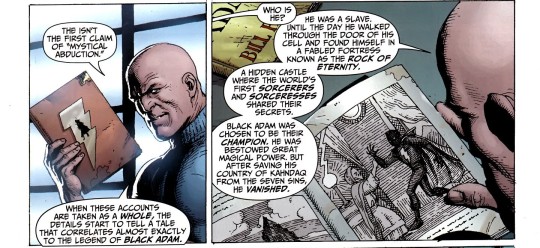
Seven months later, Billy Batson is in a boarding home and being interviewed by potential foster parents. He acts like a good boy so the Vasquezes will become his foster parents. As soon as they leave he makes insulting comments and is excited to have finally tricked someone into getting him out of there.


Billy Batson begins his new life with the Vasquezes, but he has a hard time adjusting to his foster family.




Billy Batson and his foster siblings go to school. While walking home, some kids start bullying them, and Billy fights them off. The principal threatens to expel Billy.
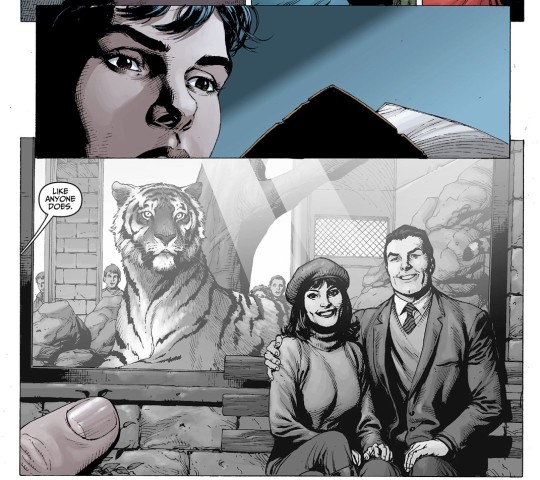
Doctor Sivana finds a door in his archaeological dig that he thinks is the tomb of Black Adam. He tries to open it, and lightning emits from the door and strikes his face. He falls to the ground, then begins laughing, saying he can see magic.

Foster parents Victor and Rosa Vasquez discuss Billy Batson and the events of last issue. Victor suggests that Billy was doing some play acting when they met him at child services, and that he is showing his true colors now. Rosa defends Billy, suggesting that Billy's encounter with Mr. Bryer has left Billy traumatized. Mr. Bryer is the richest man in Philadelphia, and the father of the four nasty bullies who are bullying Billy's new family at school. Mr. Bryer is a pretty nasty fellow himself, and Billy had the guts to stand up to him. But now Billy has hardly touched his hamburger, and Victor is concerned. Victor expresses frustration, telling Rosa that Billy never gave them a chance.
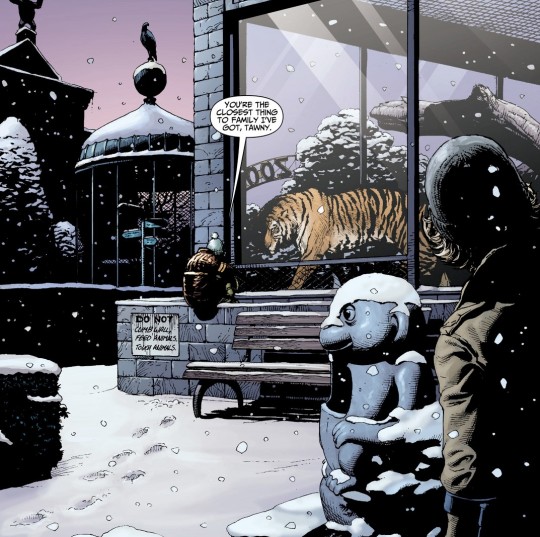
In fact, Billy is in his room, packing that hamburger in his backpack. He leaves the pickles behind, and sneaks out. Billy heads to a zoo, crawling in through a breach in the brick wall, and feeds the hamburger to Tawny, a tiger that Billy seems to know personally. Freddy tails Billy, but is eventually spotted by him. Billy pushes Freddy, who tumbles down in the snow. Freddy admits he previously lifted Billy's wallet out of curiosity, but did not steal anything.

Billy and Freddy discuss the problem with the Bryer brothers. Freddy reveals that the four bullies have been bothering them daily for quite a while. Freddy usually distracts the bullies so that Mary can help the younger ones get away.
Freddy tries to convince Billy to give Mr. and Mrs. Vasquez a chance. But Billy defiantly says "They aren't my parents."
Freddy thanks Billy for intervening when the bullies were bothering them. They consider heading to the Bryer home to get even.
45 miles north of Baghdad, Dr. Sivana continues the archaeological dig at the Tomb of Black Adam. Aided by his magical right eye, (see last issue), Sivana is now able to read the hieroglyphs. They tell him that he can release Black Adam and bring magic to the world with the utterance of a single word. Sivana quietly speaks the word "Shazam", the magic lightning hits, and a hooded Black Adam stands before him, asking for the Wizard.
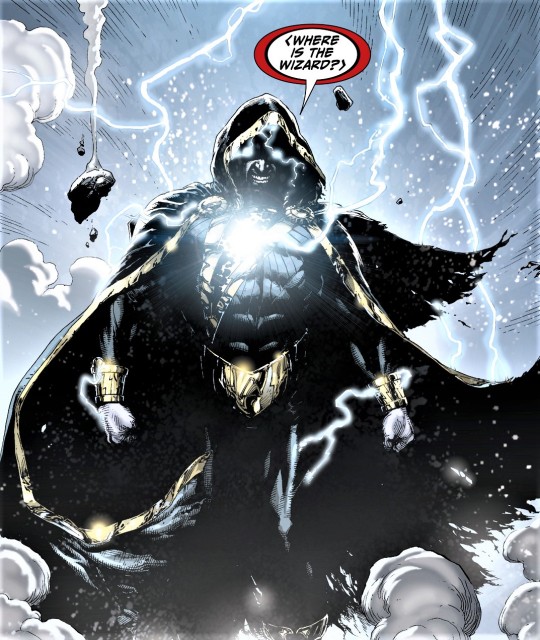
The recently freed Black Adam demands that Dr. Sivana take him to see the wizard. Meanwhile, Billy Batson and Freddy try to break into one of the Bryer's cars, but they get caught. Billy pushes Freddy in some bushes to hide him, while he escapes on the subway. But the subway doesn't take him where he thinks it will …

Billy Batson makes his way through the labyrinthine halls of the Rock of Eternity. The place seems deserted, though the boy hears the echoes of whispered voices.
“It’s just a boy.”
“What’s he look like?”
“The lad looks awfully small to me! He’ll never break the curse! Send him back already!”
Another voice, a more commanding voice, beckons him onward, deeper into the temple. He passes unimaginable marvels. Behind one door, an indoor snowstorm, memories of a childhood snowman. Down a hall, illusive specters of the Seven Deadly Sins of Man.
And at the end of the hall, six empty thrones, with an impossibly ancient man seated in the seventh. He is the last of the Council of Wizards, and the Keeper of the greatest magical fortress in all existence, the Rock of Eternity.
The Wizard seeks a mystical warrior who is pure good, but the boy his magic has summoned is far from pure.
Billy Batson doesn’t believe that a purely good person exists. “People are horrible. They disappoint you. They let you down. I’ve spent my life learning that... You’re searching for something that doesn’t really exist. That’s why you’ve never found it.”

Time runs short for the Wizard. Black Adam has already been freed from imprisonment. He searches the boy’s mind for the embers of good, seeking even a glimmer of hope.
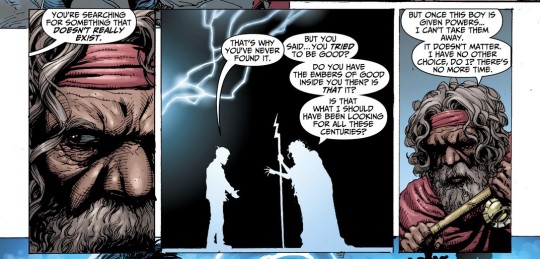
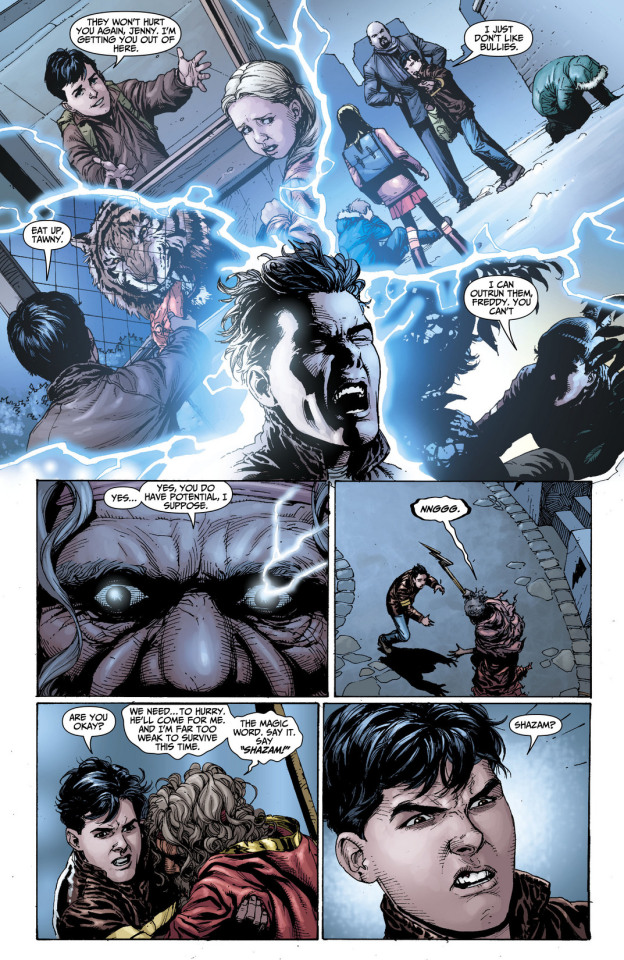
And though Billy Batson is not the warrior of pure good he sought, the Wizard does see potential in him. He teaches the boy the word that will summon his magics. The word that when spoken with purpose, with belief, with good intentions, will transform him into his greatest potential.


“SHAZAM!”
Billy Batson inherits the Wizard’s chair on the Council of Eternity, and with it, the Power of the Living Lightning. He will be able to travel through the sky as lightning does, to fight with the strength of a demigod.
And he will have to fight, to stop Black Adam from awakening the Seven Deadly Sins of Man. Black Adam will stop at nothing to become absolute ruler of all magic.
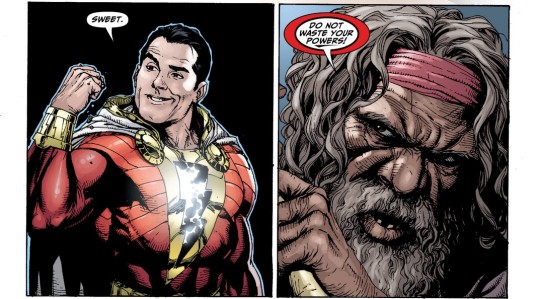
As the Wizard passes from this world, he declares Billy Batson magic’s champion. Billy Batson is now Shazam!
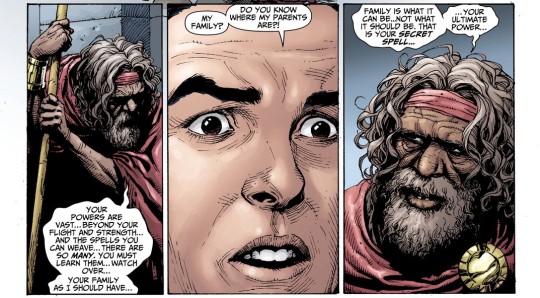
Billy Batson returns from the Rock of Eternity, now in possession of the Power of the Living Lightning. And as his first act as magic’s champion, Billy Batson pays a visit to the Bryers’ house. With his magnificent strength, he lifts the Bryers’ car into the air before casually crumpling it hood first into the ground.
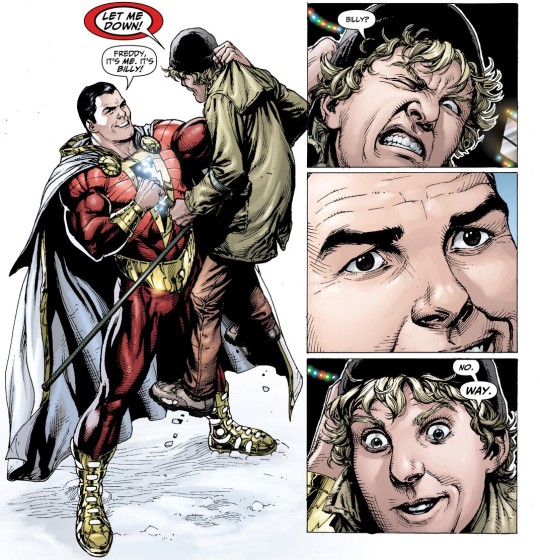
He and Freddy then try to use his now adult appearance to buy beer, but Billy feels a bit conspicuous in cloak and magic armor. He also has a hard time interacting with electrical objects, causing them to explode with living magic.

As it grows late, the criminal element of Philadelphia makes itself known. Freddy and Billy witness a mugging, and Billy decides to intervene. He swats the criminal aside, but his strength is greater than he realizes, and the man goes flying into the side of a nearby car.
The woman he saved is incredibly grateful, and she asks if there is any way she can thank him. Freddy suggests that Billy should ask for some cash, and the woman awkwardly hands him a twenty dollar bill.
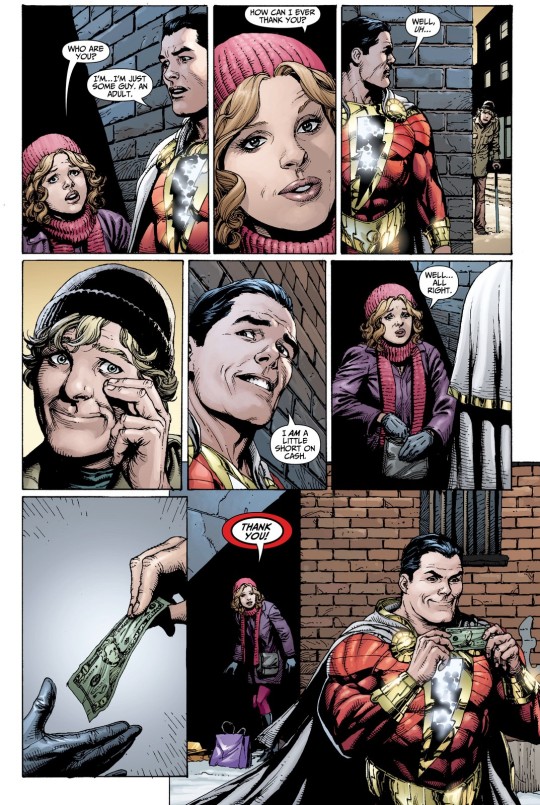
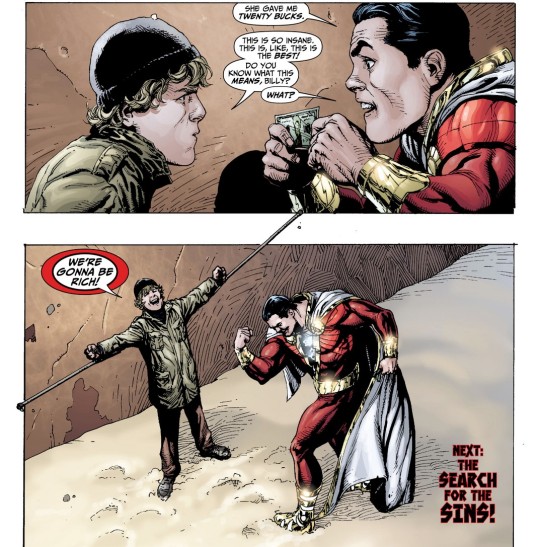
As the woman shouts her thanks, the boys walk away to celebrate their newfound source of income.
Black Adam and Dr. Sivana begin to track down the Seven Deadly Sins, starting with Sloth, freeing them. Meanwhile, Billy Batson and Freddy buy a coat to cover up his Shazam costume.

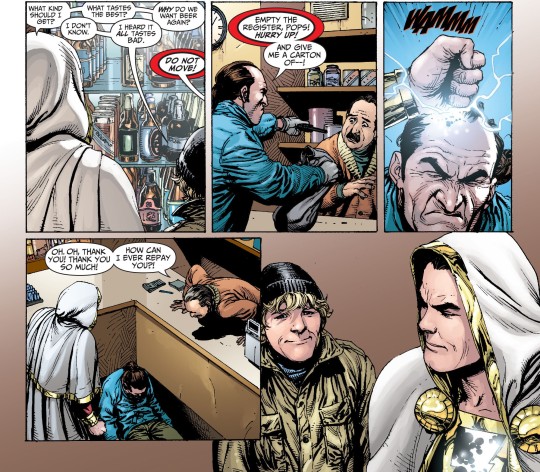
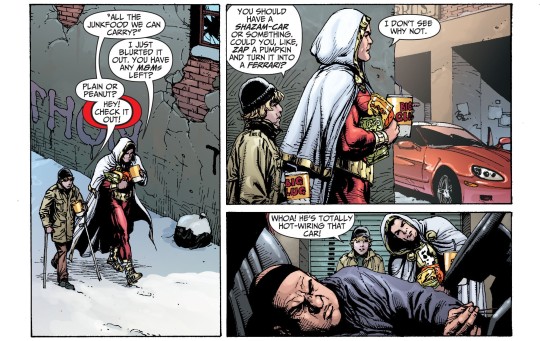
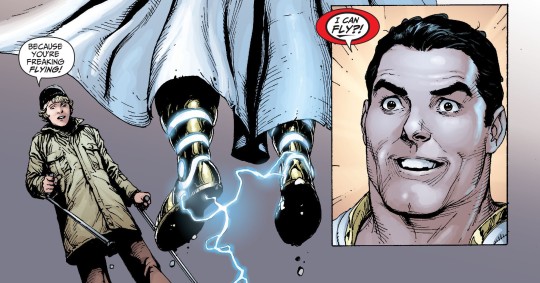
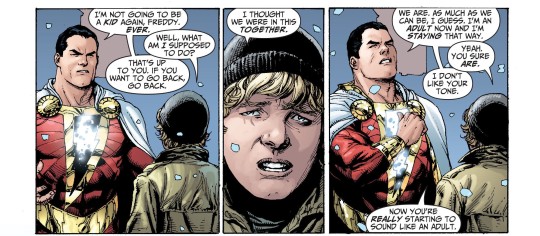
Black Adam overpowers Shazam but he escapes by transforming back into Billy and blending into the crowd.
While Black Adam is looking for Shazam, Billy Batson and his foster family try to visit the old wizard, so Billy can convince him to give his powers to someone else. But this cannot happen. Francesca shows Billy the origin of Black Adam. Billy, seeing that this is the story of a kid, storms out to confront Black Adam, only to find out the kid didn’t make it.
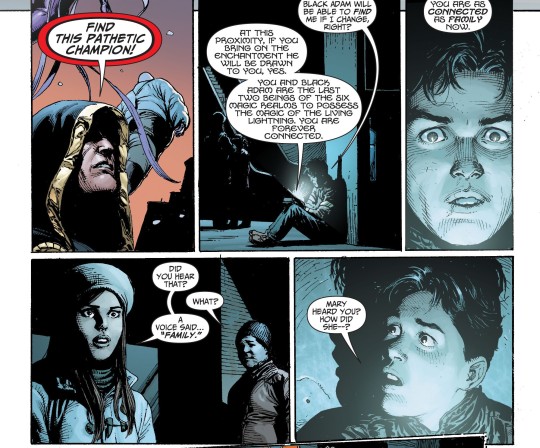
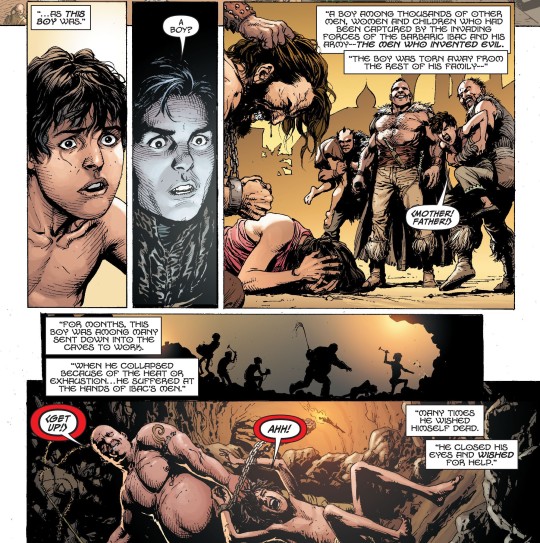
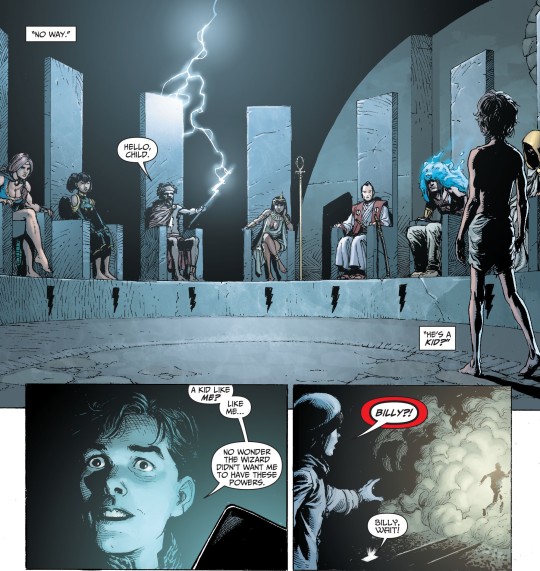
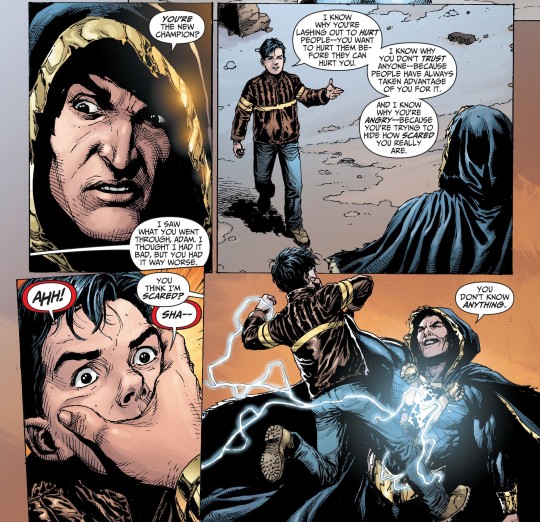
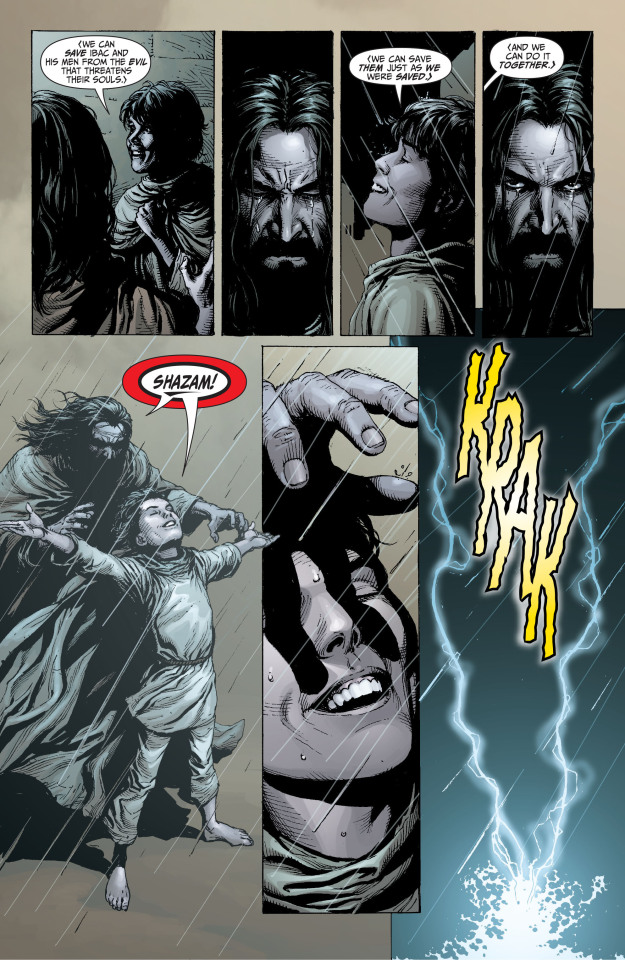
Shazam transfers some of his powers to his friends to help him fight Black Adam and the Seven Deadly Sins. As the battle continues, Shazam is still overpowered and his friends return to normal. Instead, Shazam turns back into Billy and provokes Black Adam to do the same; he does and dies as his mortal form is centuries old.
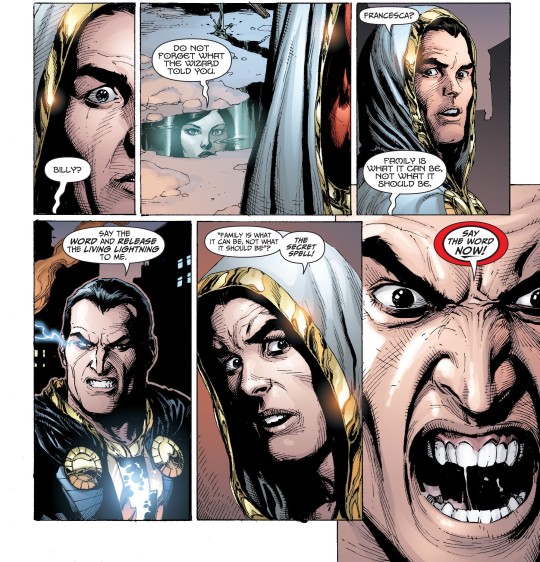
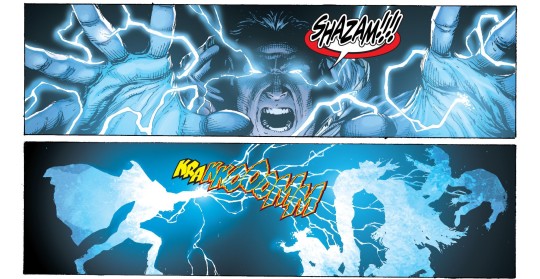
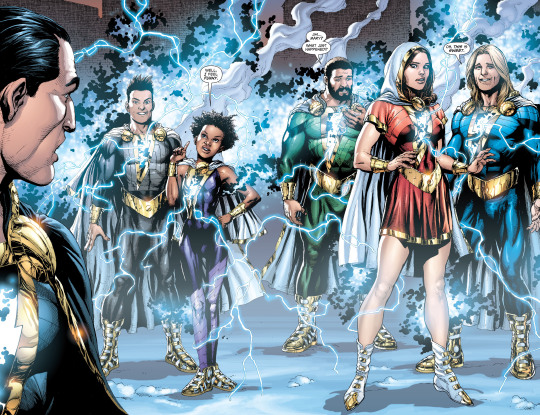
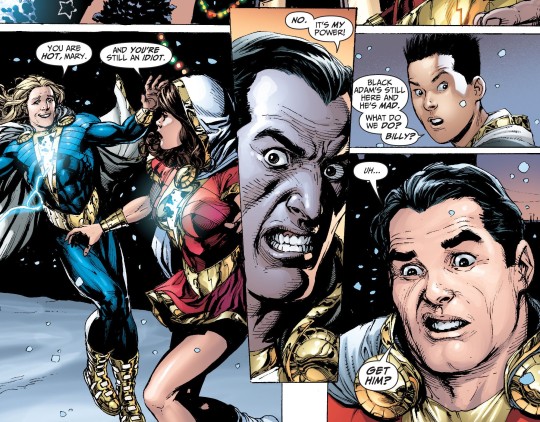
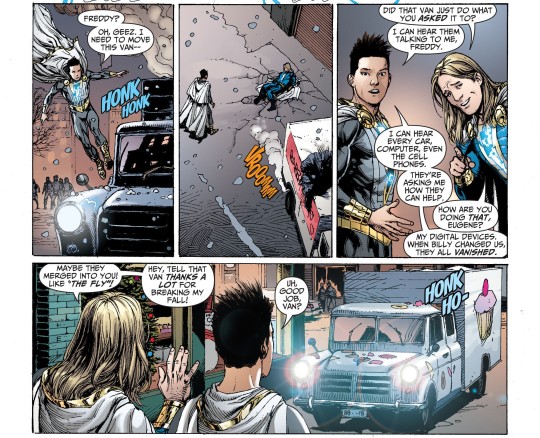

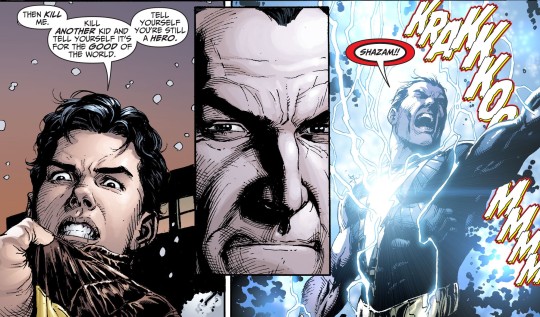

With Black Adam gone, the Seven Sins flee from battle. Billy returns to his daily life and celebrates Christmas with his friends.
REVIEW
Geoff Johns had a terrible task at hand. He would need to give Shazam a “rebirth” treatment. A character that, while not broken, had a lengthy history of real-life legal drama. In this context, Geoff Johns had to create Shazam and the Shazam Family. I don’t need to tell you that these didn’t exist before (except for the Wizard Shazam).
For those coming late to the party, Shazam’s name was always Captain Marvel. After the legal battle that canceled Captain Marvel’s titles at Fawcett, National (DC) got the rights to the character (not at once, though). By the time Captain Marvel was brought back (the seventies), Marvel Comics got the trademark for Captain Marvel and made sure to create a character with that name (not Carol Danvers). There were also other attempts of using that name by other publishers.
So, from that moment on, DC wasn’t able to use the “Captain Marvel” name on the covers of this character. Instead they would use sentences around the name Shazam. The character in the interior would still be called Captain Marvel, and his extended family would keep their names as well.
But after Flashpoint, calling the character’s name was a golden opportunity. This would also change the names of his extended family. So this is why I am saying, the character is not the same... but at the same time, it is. It’s very similar to the golden age Flash and the silver age Flash. They were almost the same, but had different names.
When I started reading this, back in 2012, I was intrigued by the change in Billy Batson’s personality. This change makes sense, and it is part of his arc. When we start his story, he doesn’t trust anyone, he can only rely on himself. Within a year, he will learn to trust his family (and recognize that a family doesn’t have to be biologically linked to you). This is a very good approach to it, because Billy and all his other “siblings” are adopted from different families. The idea that you can create your own family if life doesn’t really give you one, is quite powerful here.
Billy and Freddy’s reaction to the powers are also amazing. You see a superhero having attitudes of a kid. Gary Frank is so good at this, it feels weird seeing Shazam act like Billy. Captain Marvel was always fantasy, always mild and good, and this adaptation brings reality to it, brings different personalities and points of view. While I don’t think Shazam/Capt Marvel needed this change... it is welcome.
Now, is this enough to establish the character? NO. Most of us readers still call him Captain Marvel, or Mary Marvel, or Captain Marvel Jr, or the Marvel Family. We need to get used to the change. And there was no follow up to this arc, for 5 years. Only brought back thanks to the movie. So my wish is that this movie succeeds at changing “Shazam”’s status quo, so we can start calling him by his new name.
I appreciate the tightness of the writing as well. Side characters are justified and the main character has a very acceptable trauma for his reality.
The only character that gets a bit lost by all the events is Sivana. He keeps repeating that only magic can save his family, but this is never explored (this was just the beginning, and I am guessing it will be explored in the new title).
And Gary Frank is a god here. This may not be the breath-taking experience that “Power of Shazam” was... but his Billy Batson is very distinguishable.
I give this story a score of 10
#shazam#captain marvel#dc comics#new 52#post modern age#comics#review#2012#2013#black adam#sivana#justice league#gary frank#marvel family#shazam family
82 notes
·
View notes
Text
The Two Dynamics That Keep Religious Life Alive
QUESTION: It was previously stated that the method of supporting religious life and maintaining its vitality has two important aspects; the first is “enjoining the good and forbidding the evil” and the second is raqaiq—the matters that soften the heart. Could you explain these two aspects, particularly in terms of their relevance to our time?
ANSWER: “Enjoining the good and forbidding the evil,” means enjoining others to what religion enjoins, and averting them from what religion forbids. According to the Maturidi School of Islamic Theology and Hanafi scholars, it means enjoining people to what sound reason welcomes, and averting people from what sound reason dislikes. In other words, “enjoining the good and forbidding the evil” means letting whatever is good and beautiful in truth become widespread among people, as well as encouraging them to give up, and protecting them against, whatever is evil and ugly.
The Most Important Obligation
In order to carry out this duty in a way that is systematic and embraces the entire society, from the Prophet’s time onward, different means were utilized. They gave sermons, counsels and established circles of spiritual lessons; these activities have continued up until the present day in different forms. The most lively, striking and effective examples occurred in dervish lodges, because generally the guides who served there addressed the people with the true voice of their hearts. With their consciences that predominated over their logic, they tried to influence hearts, through the tongue of the Spiritual Intellect (lateefa Rabbaniyya), the secret (sirr), the hidden (khafi), and the most hidden (akhfa), and they reached into people’s spirits. The guides always stirred up the religious vitality of those they addressed by greatly inspiring them with the Divine Names, Attributes and the Divine Essence.
Since “Enjoining the good and forbidding the evil” is an important factor that helps keep religious life fresh, its neglect caused religious life to gradually lose its vitality and the people to be alienated from their religious values. There used to be certain days of privation in terms of religious feeling and thought. Relatively speaking we may claim to be in a better state today on the issue of “enjoining the good and forbidding the evil.” However, it is a reality that we are actually still at a very rudimentary level in comparison to the time of the blessed Prophet, peace and blessings be upon him. This duty is upon the shoulders of each Muslim today as an obligation of the utmost priority. In terms of our revival it is a dynamic that cannot be replaced by anything else.
Raqaiq: Matters That Soften the Heart
As for raqaiq, it is the narration of the issues that will soften hearts, activate the spirit, direct people’s attention to the afterlife, evoke concern in hearts about the weighing of deeds, and will also enkindle hope from God, may His glory be exalted, in hearts; all of which help in observing a flawless religious life. In this respect, raqaiq is a different form of guidance that is special to believers. Raqaiq pertains to the issues related to faith and Islam, particularly to subjects that concern their ultimate ending. For example, the encounter with the Angel of Death, what happens after the burial, the punishment of the grave, life in the Intermediate Realm (barzakh), the Day of Judgment, weighing of deeds and the like.
At the same time, Tanbih al-Ghafilin (Admonition for the Neglectful) by Abu’l-Lays Samarqandi, a significant Hanafi scholar, is accepted as one of the most important works in this field. In the first chapter of this work, he deals with the topic of sincerity (ikhlas), then other topics such as Paradise, Hell and the weighing of deeds. In the final chapter, he tells of Satan’s encounter with the noble Prophet. While dealing with these topics, he may not have been as scrupulous as Imam Bukhari, Muslim and an-Nasa’i were. The same situation holds true for Imam al-Ghazali’s Revival of Religious Disciplines. In terms of methodology, they saw no harm in relating weak hadith which pertain to religious encouragement or discouragement. However, Imam Qurtubi, who also authored such a work, was much more meticulous and careful on this issue. Being a leading Islamic scholar of jurisprudence, at the same time his proficiency in Qur’anic exegesis is apodictic. Another astonishing quality is that, although he lived in Andalusia, he had knowledge of all scholarly works authored in the East. The same thing can also be observed in Ibn Hayyan. Although they lived at the far west of the Islamic world, they had knowledge of the works from different Islamic lands such as Central Asia, Damascus, Egypt, Madinah and Baghdad. One cannot help but appreciate with astonishment and admiration this religious zeal of theirs.
So many scholars so far have dealt with the topics of raqaiq, which is a very important factor for keeping religious life alive, and authored works about this issue. However, in order for these to have the desired effect on hearts and impact on spirits, one needs to have a sound faith in the first place. However much progress people make in terms of their faith and its levels of certainty, they will be receptive to what is told and written in the same degree, keep away from vices and be eager for acts of worship. Undoubtedly, the attitudes of people who have gained such a degree of responsiveness on religious matters will be every different. Otherwise, the words uttered will bump against a bronze wall and not have any influence on those addressed.
Death; Which Makes Pleasures Bitter
The exercise of imagining death is one of the issues related to raqaiq and merits contemplation. It is an act of thinking about death and beyond, bringing to mind the dread and loneliness of the grave, remembering the perils that await a person on the road to the afterlife and living with the consideration that death may come at any moment. In other words, not thinking, “I am still young anyway. Given that I am twenty, I probably have some sixty more years before I die. Some people live to see their eighties,” but seeing death as a surprise visitor that can appear at anytime, and making preparations accordingly. As an Arab poet said, “Death comes all of a sudden; and the grave is a chest of deeds.” So, whatever a person has gained so far will be the provisions he takes along with him.
Such a sentiment is very important for the sake of the afterlife, for if a person did not walk on a safe road in the worldly life, then the road will not be safe for him in the afterlife either. Thus, that person will have to travel a very dangerous road in the afterlife. Since the exercise of imagining death makes a person gain constant awareness in this respect and makes him think about what will be beyond the grave, it is an important factor that needs to be made use of.
As it is known, during the early period of Islam, the noble Prophet prohibited believers from visiting graves, probably due to the improper practices relating to graves that remained from the Age of Ignorance. However, after some time, when this mistaken understanding was abolished, he stated: “I prohibited you from visiting graves. Now visit graves, for it reminds you of the afterlife.”
In short, both fulfilling the duty of “enjoining the good and forbidding the evil” and constantly remembering the matters of raqaiq, resembles the arteries and veins in a body. Just as the entire body’s vitality depends on them, the continuity of vitality in religion similarly depends on fulfilling these two factors. This way, a person will concentrate on his own ending, become sober-hearted, take every step with self-possession and spend every moment of his life with a consideration of self-criticism.
#allah#god#muhammad#prophet#sunnah#quran#ayat#hadith#revert#convert#reminder#religion#dua#salah#pray#prayer#islam#muslim#muslimah#hijab#welcome to islam#how to convert to islam#new muslim#new revert#new convert#help#revert help#islam help#muslim help#convert help
2 notes
·
View notes
Text
THE DIMENTIONS OF PROPHET MUHAMMAD’S (saw) PROPHETHOOD : The Ethos Created by the Messenger. Part3
Abu al-Rayhan al-Biruni was one of the greatest scholars of medieval Islam, and certainly the most original and profound. He was equally well-versed in mathematics, astronomy, the physical and natural sciences, and also distinguished himself as a geographer and historian, a chronologist and linguist, and as an impartial observer of customs and creeds. Such figures as al-Kharizmi (mathematics), Ibn Shatir (astronomy), al-Khazini (physics), Jabir ibn Hayyan (medicine) are remembered even today. Andalucia (Muslim Spain) was the main center from which the West acquired knowledge and enlightenment for centuries.
Islam founded a most brilliant civilization. This should not be considered surprising, for the Qur’an begins with the injunction:
Read: In the Name of Your Master Who creates (96:1).
The Qur’an told people to read when there was very little to read and most people were illiterate. What we understand from this apparent paradox is that humanity is to “read” the universe itself as the “Book of Creation.” Its counterpart is the Qur’an, a book of letters and words. We are to observe the universe, perceive its meaning and content, and through those activities gain a deeper perception of the beauty and splendor of the Creator’s system and the infinitude of His Might. Thus we are obliged to penetrate into the universe’s manifold meanings, discover the Divine laws of nature, and establish a world in which science and faith complement each other. All of this will enable us to attain true bliss in both worlds.
In obedience to the Qur’an’s injunctions and the Prophet’s example, Muslims studied the Book of Divine Revelation (the Qur’an) and the Book of Creation (the universe) and eventually erected a magnificent civilization. Scholars from all over Europe benefited from the centers of higher learning located in Damascus, Bukhara, Baghdad, Cairo, Faz, Qairwan, Zeituna, Cordoba, Sicily, Isfahan, Delhi and other great Islamic cities. Historians liken the Muslim world of the medieval ages, dark for Europe but golden and luminous for Muslims, to a beehive. Roads were full of students, scientists, and scholars traveling from one center of learning to another.
For the first 5 centuries of its existence, the realm of Islam was a most civilized and progressive area. Studded with splendid cities, gracious mosques, and quiet universities, the Muslim East offered a striking contrast to the Christian West, which was sunk in the Dark Ages. Even after the disastrous Mongol invasions and Crusades of the thirteenth century ce and onwards, it displayed vigor and remained for ahead of the West.
Although Islam ruled two-thirds of the known civilized world for at least 11 centuries, laziness and negligence of what was going on beyond its borders caused it to decay. However, it must be pointed out clearly that only Islamic civilization decayed—not Islam. Military victories and superiority, which continued into the eighteenth century, encouraged Muslims to rest on their laurels and neglect further scientific research. They abandoned themselves to living their own lives, and recited the Qur’an without studying its deeper meanings. Meanwhile, Europe made great advances in sciences, which they had borrowed from the Muslims.
What we call “sciences” are, in reality, languages of the Divine Book of Creation (another aspect of Islam). Those who ignore this book are doomed to failure in this world. When the Muslims began to ignore it, it was only a matter of time before they would be dominated by some external force. In this case, that external force was Europe. European cruelty, oppression, and imperialism also contributed greatly to this result.
The present modern civilization cannot last for long, for it is materialistic and cannot satisfy humanity’s perennial needs. Such Western sociologists as Oswald Spengler have predicted its collapse on the grounds that it is against human nature and values. On the other hand, Islam has been around for 14 centuries. In addition, it is fully capable of establishing the bright world of the future on the firm foundation of its creed, ethics, spirituality, and morality, as well as its legal, social and economic structures.
#allah#god#islam#muslim#quran#revert#convert#convert islam#revert islam#reverthelp#revert help#revert help team#help#islamhelp#converthelp#pray#dua#hijab#religion#mohammad#new muslim#new revert#new convert#how to convert to islam#convert to islam#welcome to islam
0 notes
Text
Islam Saved Jewry
By David J. Wasserman
May 24, 2012
This is an unpopular, discomforting claim in the modern world. But it is a historical truth. The argument for it is double. First, in 570 CE, when the Prophet Mohammad was born, the Jews and Judaism were on the way to oblivion. And second, the coming of Islam saved them, providing a new context in which they not only survived, but flourished, laying foundations for subsequent Jewish cultural prosperity – also in Christendom – through the medieval period into the modern world.
By the fourth century, Christianity had become the dominant religion in the Roman empire. One aspect of this success was opposition to rival faiths, including Judaism, along with massive conversion of members of such faiths, sometimes by force, to Christianity. Much of our testimony about Jewish existence in the Roman empire from this time on consists of accounts of conversions.
Great and permanent reductions in numbers through conversion, between the fourth and the seventh centuries, brought with them a gradual but relentless whittling away of the status, rights, social and economic existence, and religious and cultural life of Jews all over the Roman empire.
A long series of enactments deprived Jewish people of their rights as citizens, prevented them from fulfilling their religious obligations, and excluded them from the society of their fellows.
This went along with the centuries-long military and political struggle with Persia. As a tiny element in the Christian world, the Jews should not have been affected much by this broad, political issue. Yet it affected them critically, because the Persian empire at this time included Babylon – now Iraq – at the time home to the world’s greatest concentration of Jews.
Had Islam not come along, Jewry in the west would have declined to disappearance and Jewry in the east would have become just another oriental cult
Here also were the greatest centres of Jewish intellectual life. The most important single work of Jewish cultural creativity in over 3,000 years, apart from the Bible itself – the Talmud – came into being in Babylon. The struggle between Persia and Byzantium, in our period, led increasingly to a separation between Jews under Byzantine, Christian rule and Jews under Persian rule.
Beyond all this, the Jews who lived under Christian rule seemed to have lost the knowledge of their own culturally specific languages – Hebrew and Aramaic – and to have taken on the use of Latin or Greek or other non-Jewish, local, languages. This in turn must have meant that they also lost access to the central literary works of Jewish culture – the Torah, Mishnah, poetry, midrash, even liturgy.
The loss of the unifying force represented by language – and of the associated literature – was a major step towards assimilation and disappearance. In these circumstances, with contact with the one place where Jewish cultural life continued to prosper – Babylon – cut off by conflict with Persia, Jewish life in the Christian world of late antiquity was not simply a pale shadow of what it had been three or four centuries earlier. It was doomed.
Had Islam not come along, the conflict with Persia would have continued. The separation between western Judaism, that of Christendom, and Babylonian Judaism, that of Mesopotamia, would have intensified. Jewry in the west would have declined to disappearance in many areas. And Jewry in the east would have become just another oriental cult.
But this was all prevented by the rise of Islam. The Islamic conquests of the seventh century changed the world, and did so with dramatic, wide-ranging and permanent effect for the Jews.
Within a century of the death of Mohammad, in 632, Muslim armies had conquered almost the whole of the world where Jews lived, from Spain eastward across North Africa and the Middle East as far as the eastern frontier of Iran and beyond. Almost all the Jews in the world were now ruled by Islam. This new situation transformed Jewish existence. Their fortunes changed in legal, demographic, social, religious, political, geographical, economic, linguistic and cultural terms – all for the better.
First, things improved politically. Almost everywhere in Christendom where Jews had lived now formed part of the same political space as Babylon – Cordoba and Basra lay in the same political world. The old frontier between the vital centre in Babylonia and the Jews of the Mediterranean basin was swept away, forever.
Political change was partnered by change in the legal status of the Jewish population: although it is not always clear what happened during the Muslim conquests, one thing is certain. The result of the conquests was, by and large, to make the Jews second-class citizens.
This should not be misunderstood: to be a second-class citizen was a far better thing to be than not to be a citizen at all. For most of these Jews, second-class citizenship represented a major advance. In Visigothic Spain, for example, shortly before the Muslim conquest in 711, the Jews had seen their children removed from them and forcibly converted to Christianity and had themselves been enslaved.
In the developing Islamic societies of the classical and medieval periods, being a Jew meant belonging to a category defined under law, enjoying certain rights and protections, alongside various obligations. These rights and protections were not as extensive or as generous as those enjoyed by Muslims, and the obligations were greater but, for the first few centuries, the Muslims themselves were a minority, and the practical differences were not all that great.
Along with legal near-equality came social and economic equality. Jews were not confined to ghettos, either literally or in terms of economic activity. The societies of Islam were, in effect, open societies. In religious terms, too, Jews enjoyed virtually full freedom. They might not build many new synagogues – in theory – and they might not make too public their profession of their faith, but there was no really significant restriction on the practice of their religion. Along with internal legal autonomy, they also enjoyed formal representation, through leaders of their own, before the authorities of the state. Imperfect and often not quite as rosy as this might sound, it was at least the broad norm.
The political unity brought by the new Islamic world-empire did not last, but it created a vast Islamic world civilisation, similar to the older Christian civilisation that it replaced. Within this huge area, Jews lived and enjoyed broadly similar status and rights everywhere. They could move around, maintain contacts, and develop their identity as Jews. A great new expansion of trade from the ninth century onwards brought the Spanish Jews – like the Muslims – into touch with the Jews and the Muslims even of India.
A ll this was encouraged by a further, critical development. Huge numbers of people in the new world of Islam adopted the language of the Muslim Arabs. Arabic gradually became the principal language of this vast area, excluding almost all the rest: Greek and Syriac, Aramaic and Coptic and Latin all died out, replaced by Arabic. Persian, too, went into a long retreat, to reappear later heavily influenced by Arabic.
The Jews moved over to Arabic very rapidly. By the early 10th century, only 300 years after the conquests, Sa’adya Gaon was translating the Bible into Arabic. Bible translation is a massive task – it is not undertaken unless there is a need for it. By about the year 900, the Jews had largely abandoned other languages and taken on Arabic.
The change of language in its turn brought the Jews into direct contact with broader cultural developments. The result from the 10th century on was a striking pairing of two cultures. The Jews of the Islamic world developed an entirely new culture, which differed from their culture before Islam in terms of language, cultural forms, influences, and uses. Instead of being concerned primarily with religion, the new Jewish culture of the Islamic world, like that of its neighbours, mixed the religious and the secular to a high degree. The contrast, both with the past and with medieval Christian Europe, was enormous.
Like their neighbours, these Jews wrote in Arabic in part, and in a Jewish form of that language. The use of Arabic brought them close to the Arabs. But the use of a specific Jewish form of that language maintained the barriers between Jew and Muslim. The subjects that Jews wrote about, and the literary forms in which they wrote about them, were largely new ones, borrowed from the Muslims and developed in tandem with developments in Arabic Islam.
Also at this time, Hebrew was revived as a language of high literature, parallel to the use among the Muslims of a high form of Arabic for similar purposes. Along with its use for poetry and artistic prose, secular writing of all forms in Hebrew and in (Judeo-)Arabic came into being, some of it of high quality.
Much of the greatest poetry in Hebrew written since the Bible comes from this period. Sa’adya Gaon, Solomon Ibn Gabirol, Ibn Ezra (Moses and Abraham), Maimonides, Yehuda Halevi, Yehudah al-Harizi, Samuel ha-Nagid, and many more – all of these names, well known today, belong in the first rank of Jewish literary and cultural endeavour.
W here did these Jews produce all this? When did they and their neighbours achieve this symbiosis, this mode of living together? The Jews did it in a number of centres of excellence. The most outstanding of these was Islamic Spain, where there was a true Jewish Golden Age, alongside a wave of cultural achievement among the Muslim population. The Spanish case illustrates a more general pattern, too.
What happened in Islamic Spain – waves of Jewish cultural prosperity paralleling waves of cultural prosperity among the Muslims – exemplifies a larger pattern in Arab Islam. In Baghdad, between the ninth and the twelfth centuries; in Qayrawan (in north Africa), between the ninth and the 11th centuries; in Cairo, between the 10th and the 12th centuries, and elsewhere, the rise and fall of cultural centres of Islam tended to be reflected in the rise and fall of Jewish cultural activity in the same places.
This was not coincidence, and nor was it the product of particularly enlightened liberal patronage by Muslim rulers. It was the product of a number of deeper features of these societies, social and cultural, legal and economic, linguistic and political, which together enabled and indeed encouraged the Jews of the Islamic world to create a novel sub-culture within the high civilisation of the time.
This did not last for ever; the period of culturally successful symbiosis between Jew and Arab Muslim in the middle ages came to a close by about 1300. In reality, it had reached this point even earlier, with the overall relative decline in the importance and vitality of Arabic culture, both in relation to western European cultures and in relation to other cultural forms within Islam itself; Persian and Turkish.
Jewish cultural prosperity in the middle ages operated in large part as a function of Muslim, Arabic cultural (and to some degree political) prosperity: when Muslim Arabic culture thrived, so did that of the Jews; when Muslim Arabic culture declined, so did that of the Jews.
In the case of the Jews, however, the cultural capital thus created also served as the seed-bed of further growth elsewhere – in Christian Spain and in the Christian world more generally.
The Islamic world was not the only source of inspiration for the Jewish cultural revival that came later in Christian Europe, but it certainly was a major contributor to that development. Its significance cannot be overestimated.
David J Wasserstein is the Eugene Greener Jr Professor of Jewish Studies at Vanderbilt University. This article is adapted from last week’s Jordan Lectures in Comparative Religion at the School of Oriental and African Studies.
0 notes
Text
US Coalition to Leave Iraq ‘In Due Deference to Sovereignty’ – General
Head of US forces in Iraq informed Baghdad that US-led coalition will indeed be leaving the country, contrary to public remarks by President Trump

US soldiers run toward a UH-60 Blackhawk helicopter during an air assault training event in Baghdad, 2009
Citing a vote in the Iraqi parliament, the head of US forces in Iraq has informed the government in Baghdad that the US-led coalition will be leaving the country, in a letter that contradicts President Trump's earlier statements.
“In due deference to the sovereignty” of Iraq, the Combined Joint Task Force Iraq will be “repositioning forces over the course of the coming days and weeks to prepare for onward movement,” Marine General William H. Seely III wrote in a letter to the Iraqi Defense Ministry on Monday, which has surfaced online.

“We respect your sovereign decision to order our departure,” Seely wrote, explaining that the process will involve increased helicopter traffic into and out of Baghdad’s “green zone,” mainly during the night-time, with the Coalition seeking to “minimize and mitigate” disturbances to civilians.
There was initially some confusion about the letter's authenticity, with the Pentagon declining to confirm it was real However, US Army public affairs officer Rick Dickson stated shortly after the news broke that the letter is "official and accurate."
The Iraqi parliament adopted a resolution on Sunday seeking to “end the presence of any foreign troops on Iraqi soil,” prompted by last week’s US drone strike that killed Iranian General Qassem Soleimani and a number of Iraqi Shia militia officials at the Baghdad International Airport.
US President Donald Trump responded by threatening sanctions and saying the US will not leave until the Iraqis “pay us back” for an airbase that he said cost billions of dollars to build.
“Trump threatens Iraq with ‘very big sanctions’ unless it pays back BILLIONS for an airbase if US troops are forced to withdraw.” “If they do ask us to leave, if we don’t do it in a very friendly basis, we will charge them sanctions like they’ve never seen before ever. It’ll make Iranian sanctions look somewhat tame.”
Secretary of State Mike Pompeo likewise dismissed the non-binding resolution, saying that he was “confident that the Iraqi people want the United States to continue to be there to fight the counterterror campaign.”
The US-led coalition forces were sent to Iraq in 2014, to help the government in Baghdad confront Islamic State (IS, formerly ISIS) terrorists that had taken a significant portion of Iraqi territory, all of which has since been liberated.
— RT
0 notes
Text
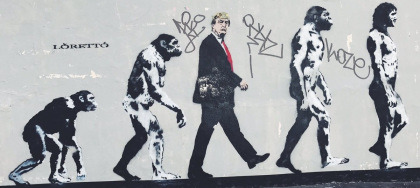
Its been a long while since Isaac Watts (1674-1748) wrote Against Lying; a poetic comment on the slippery slope of lying as one lie follows another, then another, until the number of porkies told in a lifetime probably stretches all the way to Pluto and back.
We learn the art of lying at a very early age from observing and listening to parents and relatives, who themselves picked it up from their own relatives and parents, which then transfers to the larger combat zone of school, and onward into the armageddon of adulthood where we are surrounded by lies, not just the tiny ones childhood taught us, but humongous whoppers flung blithely at us by employers, capitalism and of course, politicians, without pausing for breath or blinking an eye in shame.
No one expects a politician to tell us the truth, but we still vote for them, so who is to blame here for serial lying becoming the gold standard for politics and the capitalist economy?
I just witnessed an interview with the father of Boris Johnson the UK prime minister; now Boris is a serial liar of a certain distinction, he has progressed to way beyond the tipping point of retaining a sliver of recognition that he might not be telling the whole truth, to one where he cannot help his tongue gallop away with an entire regiment of lies in the face of questions. He looks genuinely shocked that anyone could entertain the thought that he was an habitual liar, but this goes for all his colleagues in government; every one of them is a seasoned and consummate liar and fabricator of the truth.
Boris Johnson`s father was told people were comparing his son to Pinocchio, to which he replied that he seriously doubted “the people” could spell Pinocchio, let alone know who, or what Pinocchio was.
This was a blatant show of the elite`s contempt for the general level of intellectual nous of the public; the only answer to it is to vote in a government that will spend whatever it takes on education, to make sure there is an intellectually high calibre electorate to understand exactly what politicians are saying to them.
Unfortunately, I have yet to experience a government that has even begun to fund the education system to sufficiently high levels, to guarantee everyone not only knows who Pinocchio is, but why his name is equated with Boris Johnson. This is because the political and social elites fear an educated electorate, one which fully understands what is being said to them, and then acting accordingly.
I have never experienced such a monumentally high level of what is colloquially called disinformation in global politics. We see fascist demagogues in charge all over the planet, who have lied, cheated, and defamed their rivals to get to the top table, and once there, they rig the system to ensure its well nigh impossible, short of a military coup, to dislodge them. All of this is done with the connivance of a large enough slice of their electorates to ensure success; and what do so many of these countries have in common? A cultural environment which does not encourage and adulate high academic success for the masses: this environment is sustained by the elite of each nation by all means at their disposal, to keep the status quo as it is in their favour, because they know education is their biggest enemy.
The system is ultimately rigged against high education for the many by the elite few even in countries like the United States where the underfunded public school system is a battleground more reminiscent of Baghdad than the supposedly richest country on the planet. If America is so wealthy, one wonders who and where that money is being syphoned off to, certainly not for providing the finest education money can buy for the vast majority of the people.
So, it is rather easy to peddle lies as truth, and confidently expect the electorate to swallow the bait; those that are savvy enough to stand back and intellectually evaluate the truth from the lie, are not enough to hinder the fabricators of fake news and lies from continually hitting a homerun every time they open their mouths, or write their articles of untruth.
All this basically means that the human race will never evolve upward, but it can be argued, it has already clawed up as far as its going to get, and the only direction is down. The Descent of Man has enabled fake news, lies, dissembling, obfuscation and deception to reach new heights, as the human animal starts its decline back to the cave. Only, the fire has been replaced by people peering into their cell phones on fake news sites, believing it all as total gospel, and then knuckle dragging and grunting their way to a poll booth, scrawling a cross somewhere near the right spot, then shuffling their way back to the family cave for another shock of reality television, slouched on the nearest comfy boulder.
Isaac Watts didn`t know what he was missing out on.
Power To The People…Or, those who can at least think for themselves.


“The victor will never be asked if he told the truth.”
~~ Adolf Hitler ~~
KEEP OFF OUR WORMS Its been a long while since Isaac Watts (1674-1748) wrote Against Lying; a poetic comment on the slippery slope of lying as one lie follows another, then another, until the number of porkies told in a lifetime probably stretches all the way to Pluto and back.
0 notes
Text
World War I (Part 10): The Ottoman Turks
Turkey and the Ottoman Empire had nothing directly to do with the July crisis that lead up to WW1, but it would not have happened were it not for them. If the Ottoman Empire hadn't been falling apart, the Hapsburgs wouldn't have annexed Bosnia, and there wouldn't have been an independent Serbia. Nor would there have been a power vacuum in the Balkans, which Russia and Austria-Hungary were pulled into, and thus into that level of conflict with each other.
It wasn't just the decline, but the also the earlier rise of the Ottoman Empire that caused the Balkan situation. The Ottomans had ruled the Balkan peninsula for 500 years. At their peak, they reached west into Italy, north into Austria, Hungary and Russia, and all the way around the Black Sea. By 1914, the Ottoman Empire still stretched across the Middle East to the Arabian Peninsula, although they had little territory in Europe.
The Ottman dynasty began with the Turko-Mongolian chieftain Osman I (c.1299 – 1323/34) in eastern Turkey. From there, they expanded in all directions. In 1354 they entered Europe, and in 1343 they took Constantinople, the heart of the Byzantine Empire. From then onwards, Constantinople would be their home. The Hagia Sophia, a Roman building, was turned into a mosque.
They kept expanding for another century after that, taking all of Eastern Europe south of the Danube, as well as other regions. Selim I (ruled 1512-20) won a battle that gave them Algeria, Egypt, Palestine and Syria, doubling the empire's size.
As their power increased, the Ottoman rulers kept harems instead of marrying – sometimes hundreds of women, kept as property and prisoners. They weren't allowed any contact with other man, except for eunuchs who served as their custodians (most of them were Africans).
Ten generations after Osman I, the Ottomans reached their peak with Selim I's son, Sultan Suleiman the Lawmaker (the Magnificent to the Christians) – but they also began their decline. His rule was from 1520-66.

Suleiman I (c.1530).
Suleiman personally led the army in 13 campaigns. Under him, they took Belgrade and Budapest, and even besieged Vienna; however, they were unable to capture it because heavy rain prevented them from bringing the heavy guns north. Suleiman was a builder, and he made Constantinople grander and more beautiful than ever before. He was also a poet, and a student of the works of Aristotle.
He had about 300 women in his harem, but everything changed when he was given Ghowrem, a red-haired Russian girl who'd been captured in a slave raid in modern Poland. She would be called Roxelana and the Hürrem Sultan, and also be known as “the witch”. After she arrived, Suleiman stopped having sex with his other women, and he eventually married her, which no Ottoman sultan had done for centuries.
Suleiman's son was called Mustafa, and he was a promising heir. He was an excellent military leader, a capable provincial governor, and a popular hero. But Roxelana wanted her own son, Selim II, to rule, so she persuaded Suleiman that Mustafa was plotting against him. Mustafa was overpowered and strangled with five professional executors, with Suleiman watching. The executors had had their eardrums broken so they wouldn't hear any secrets, and their tongues slit so they couldn't speak of what they saw.
Selim II (also called Selim the Sot) succeeded Suleiman, and he was useless. He was short, fat and a drunkard, and never fought in any war. After 8yrs, he fell down in his marble bath, fractured his skull, and died.
His son Murad III was next, but he was also a drunkard, as well as being addicted to opium. He reigned for 20yrs, and had 103 children, but didn't do much else.
Mehmed III succeeded him in 1595. At the start of his reign, he ordered all his brothers to be put to death, including the children. The sultans who followed him would do the same. Like Murad III, he spent the rest of his life on copulation and not much else. And so the pattern continued.
When a sultan died, all his women would be moved far away, and kept in strict solitude for the rest of their lives. Any who were pregnant would be murdered, usually by being drowned in sacks. The younger brothers and half-brothers of the new sultan would be murdered, too, usually by strangulation. Even the babies were killed.
A windowless building called the Cage was built, and the ruler's heirs were kept here from early childhood, until they either died (of natural causes or not), or succeeded to the throne, having been taught absolutely nothing. Thus the decline of the Ottoman Empire continued rapidly, with useless, ignorant sultans, some of whom had spent decades in the Cage. As rulers, they could do what they liked, no matter what it was. Often they would kill or main anyone they wished for any reason, such as playing the wrong music or smoking, or for no reason at all.
Between Suleiman I and WW1, only one sultan displayed any of Suleiman's abilities – Murad IV (reigned 1623-40). He became sultan when he was 10yrs old, and he'd been too young to be imprisoned in the Cage. He was the first ruler to be a soldier since the time of Suleiman, and he led the army into Persia & savagely put down an uprising there.

Murad IV.
But he was still very much like the others – in fact, he was even crueller than most sultans. In 1637 alone, 25,000 people within the empire were killed, and many of them by Murad himself. He claimed the right to kill 10 innocent people per day, and sometimes he'd just sit on a palace wall & shoot randomly at people passing by. At night, he visited Constantinople's taverns, and anyone found smoking would be killed right then.
Kara Ali, his chief executioner, followed Murad everywhere he went. In his belt he carried various tools of torture and murder, including gimlets, nails, clubs, and canisters with different kinds of powder for blinding people.
Unlike nearly all the other sultans, Murad had no children. His brother Ibrahim was his heir, and he'd been living in the Cage since the age of 2yrs. On his deathbed, Murad ordered Ibrahim to be killed, but the order was not obeyed, as he was the last living member of the Ottoman dynasty.
Ibrahim reigned from 1640-48. He built up a harem of 280 women, but upon hearing a probably-untrue report that one of them was romantically involved with an eunuch, he had them all drowned.
The Ottoman Empire was by now a good target for other powerful countries/empires. In 1798, Napoléon Bonaparte invaded Egypt and conquered it easily. He was driven out by the British navy, not by the Turks or their Egyptian subjects. More and more, the survival of the Ottoman Empire was a result not of their military or political strength, but of the rivalries of the European powers. They continued through the 1800's because Britain and France stopped Russia from finishing them off.
But in the century leading up to 1914, the Ottomans lost war after war. War with their own Turkish satraps, who wanted to achieve autonomy in Egypt, Syria, and other places. War with Arab chieftains who were seeking independence; with Persia; with the Balkan Christians. Between 1806-78, they fought Russia four times and lost each time (although Russia didn't manage to take Constantinople).
In 1830, Britain seized Algeria in North Africa. Around the same time, they began building a power base in Arabia (the Arabian Peninsula) and the Persian Gulf (also called the Arabian Gulf).

Persian Gulf.

Arabian Peninsula.
In 1853, the Crimean War broke out. Russia invaded the Ottoman provinces south of the Danube, and if Britain and France hadn't intervened to stop them, the Ottomans might have been finished in Europe.
The Russo-Turkish War was 1877-78. Britain again stopped Russia from destroying the Ottomans, because they worried that if Russia broke through to the south, their control of India and their position in the eastern Mediterranean region might be lost.
But by now, several other countries (including Britain) were taking over Ottoman European territory. Austria-Hungary took Bosnia and Herzegovina, annexing it officially in 1908. France took Tunisia & Morocco in North Africa, with British support. (Germany opposed it so strongly that for a while it seemed like war would break out between them.) Britain took Egypt and Cyprus, and Italy took Tripoli (modern Libya), as well as islands in the Aegean & Mediterranean.
Germany arrived to late to join in, so they focused on building ties with the Ottomans. They began building a Berlin-Baghdad railway, and Wilhelm II paid a state visit to Constantinople and Jerusalem.
Enver Pasha was a young army officer who lead a group of attempted reformers called the Young Turks. In 1908, when he was 27yrs old, they took control of the government, and introduced a constitution.
In 1912-13, the Turks were nearly driven entirely out of the Balkans when they lost the First Balkan War. The ruling faction's prestige was seriously damaged by 1) this massive loss, 2) their failure to carry out the expected reforms, and 3) their failure to halt the empire's decline. They were replaced by nationalist extremists led (again) by Pasha. Some of the territory they lost during that war was regained during the Second Balkan War in 1913.

Enver Pasha (right) after the 1913 coup.
The second-last Ottoman sultan was Mehmed V. He was as useless as his predecessors, and he was nothing more than a figurehead: nobody even pretended that he mattered. He had been picked as a safe choice for the throne after boasting that he hadn't read a newspaper in over 30yrs.
In January 1914, Pasha left the army and became Minister of War. In July, he made a secret defensive alliance with Germany.
Even though the Ottoman Empire had lost so much, as of July they were still geographically bigger than Austria-Hungary, Germany, and France combined. They still ruled Arabia, which would soon emerge as the world's largest source of oil. If war broke out, no-one knew whose side the Turks would fight on. They would be either an important ally, or a rich and probably easy conquest.
#book: a world undone#history#military history#ww1#crimean war#russo-turkish war#first balkan war#second balkan war#ottoman empire#turkey#osman i#suleiman i#şehzade mustafa#hürrem sultan#selim ii#murad iii#mehmed iii#murad iv#kara ali#sultan ibrahim#napoléon bonaparte#enver pasha#mehmed v#ottoman dynasty
6 notes
·
View notes
Text
Jews of Iraq
by Miriam Phelan, Assistant Curator
Over the next few months we will be exploring Sephardi Jewish communities from around the world and throughout time on the blog, alongside our exhibition Sephardi Voices: Jews from North Africa, the Middle East and Iran. Explore the historic Iraqi Jewish communities in the first of these blogs below.
The history of the Iraqi Jewish community is a long and significant one that dates back to the 6th century BCE following the destruction of the first Temple in Jerusalem, and the subsequent exile to Babylonia, in present-day Iraq.
Life improved for the Jewish captives when the Persians, under Cyrus, who conquered Babylon in 537 BCE, allowed the Jewish community to leave Babylonia and vast numbers left for Jerusalem. Many, however, chose to remain in Babylon, establishing new synagogues and a community that remained in Iraq for almost 1,000 years.
I will take you through this rich history by looking at some of the objects we have in the Jewish Museum collection, both in storage and on display.
Incantation Bowl, 5th Century
Possibly one of the oldest in the museum’s collection, this incantation bowl is thought to have originated in Iraq and was decorated with Aramaic text and images believed to have mystical powers.

The image at the base of this bowl has long since faded but would most likely have been an image of Lilith. Lilith is a female demon from Jewish mythology, first referenced in the Babylonian Talmud around the 3rd-5th centuries.
These bowls were buried upside down in the foundations of buildings as a means of protecting those inside from evil demons. During the excavation of the ancient Iraqi city of Nippur in the 19th and early 20th centuries many Jewish settlements had incantation bowls concealed in their foundations or walls. It was during this period, from the 3rd to the 5th centuries, that Babylon became the religious, cultural and scholarly centre of Judaism and when the Babylonian Talmud came to be written.
Torah Case, 19th Century
This highly decorated Torah case was made in Iraq in the late 19th century and is currently on display in our Judaism gallery.

This Torah case, or Tik, is made of wood and overlaid in silver decorated with a trellis pattern of flower-sprays and gilt ‘wheat-ear’ borders. Its inscribed top is set with small pieces of coral and a domed top hung with small bells, both common features of Torah cases made in Iraq at this time.
David Solomon Sassoon, the treasurer of Baghdad in the early 19th century, recorded in 1910 that there were more than 70 scrolls in the Baghdad Great Synagogue alone, many of them stored in cases such as this.
This highly decorated and beautiful object is indicative of the relative prosperity of the Baghdadi community during this period, although many families such as the Sassoon family, were forced to leave their homes and businesses following increasing persecution by Dawud Pasha, the Mamluk ruler of Iraq from 1816 to 1831.
Baby’s Dress, 1935
This small baby’s dress was made of cream-coloured silk with gold embroidery by a student at the Laura Kadoorie Girls' School in Baghdad in the early 1930s.

Classes for vocational skills at the school were introduced in 1923 to teach poorer children and orphans of Baghdad the skills of dressmaking and embroidery, allowing them to earn an income making clothing for the community.
From the 19th century onwards more affluent members of the community supported the provision of free education for poor or orphaned children and better healthcare as part of an increased awareness of social care within the community.
The Alliance Israelite Universelle was formed in Paris in 1860 and created a network of schools throughout the Middle East, most successful of which was the Laura Kadoorie School for Girls (founded in 1911).
Conditions continued to deteriorate in Iraq for the Jewish community after the war and the population of around 150,000 Jews in the 1940s has since reduced to just a handful today.
Although the Iraqi Jewish community diminished in the second half of the 20th century, this history remains a hugely important part of wider Jewish history. We seek to preserve the story of this ancient community by collecting and displaying objects such as those shown here.
Help us grow our collection of Sephardi objects! The objects shown here were given to the museum by Sephardi Jews who settled in the UK. We would love to have more Sephardi objects in our collection. Do you have objects representing your own story that you would be happy to donate to us? Email [email protected] and let us know.
1 note
·
View note
Text
Disintegration of Arab Hegemony (10th C.)
1. The rise of a non-Arab power elite in the Abbasid period (750-1258) played up the ecumenical, universalizing tendencies of the new Muslim faith and enriched artistic, philosophical, and scientific movements developing at this time.
2. However, this cultural efflorescence often coincided with political instability. Non-Arab claims to political rule time and again threatened the hold of the Arab Abbasid caliph in Baghdad over his vast empire. Non-Arabs, both rhetorically and substantively, chipped away at ideas of Arab exceptionalism in these centuries. That the caliph himself was often born of a non-Arab mother helped to weaken any claims that Arabic speakers could make to their special hold over political or religious authority in the Muslim world based on their "origins" from the prophet and the early community of believers.
3. The further infiltration of the military elite by Turkic-speaking migrants and slaves from Central Asia, ethnic Persians, other non-Arabs, and even non-Musims meant that the long-term survival of any Muslim polity, big and small, was of necessity a multi-ethnic and multi-religious project.
4. From the 10th century onwards, it is non-Arab and especially Turkic-speaking military elites that maintain and expand Muslim rule across Asia and Africa. This trend would continue largely uninterrupted down to the beginning of the 20th century.
0 notes
Text
What Do You Know About Imam An-Nawawi?
New Post has been published on https://www.truth-seeker.info/jewels-of-islam/what-do-you-know-about-imam-an-nawawi/
What Do You Know About Imam An-Nawawi?
By Jamal Ad-Din Zarabozo
The Life of An-Nawawi
It is important for Muslims to take the time to learn about the lives of the pious predecessors. The great scholars and pious individuals of the past can be great examples of the living. Their behaviour and actions can have a great effect on their hearts. Their examples demonstrate that in every age, there were pious Muslims who followed the way of the Prophet (PBUH) and his noble Companions, without compromise and without giving in to the desires of this world. They demonstrate to the Muslims of today that the guidance of the Qur’an and Hadith was sufficient for them to lead their lives in manners pleasing to Allah, although they did not sit with and learn directly from the Prophet (PBUH) or even his close Companions.
Today, Muslims face many of the same problems, temptations and difficulties that these pious predecessors faced. The pious predecessors read and intensively studied the Qur’an and Hadith to attain guidance for their lives. They applied the Qur’an and Sunnah in their lives under various circumstances. What they derived from the Divine Guidance should be considered light for all of those who come after them who face circumstances similar to theirs.
There are many aspects of An-Nawawi’s life, in particular, that may set an example for those living today. In his introduction to his Master’s Thesis on An-Nawawi, Ahmad al-Haddad echoed these views when he stated,
“The third reason [for writing about An-Nawawi] was to bring to the forefront of the life of this extraordinary man who lived in a later time. It is hoped that this biography will bring to us and the coming generations great benefits with respect to the seriousness and striving for knowledge, with respect to asceticism and fearing Allah, and with respect to the bravery in publicly speaking the truth. The lives of the pious have the greatest effect on those who hear about them. Allah has certainly spoken the truth when He said, “And all that We relate to you (O Muhammad) of the news of the messenger [is] in order that We may make your heart strong and firm.” (Hud 11:20)
The goal here is to be brief. Therefore, only certain aspects of his life will be highlighted.[1]
Background to An-Nawawi’s Life
Islam in the Seventh Century of Hijrah
The Seventh Century of Islam was a very turbulent time, especially for the area of Sham (Greater Syria). It was during this Century that the Mongols invaded the East and the Crusaders controlled part of the Muslim lands from the West. In the year 656H, the Mongols invaded and conquered Baghdad, the capital of the Abbasids. In 658, however, under the reign of Al-Mudhafar Qutuz ibn ‘Abdullah and military leadership of Al-Dhahir Baybars, the Muslims handed the Mongols a stunning defeat at Ayn Jalut. Also, in 679H, when the Mongols again tried to conquer Aleppo, they were defeated. From that time onwards, Muslim forces continue to battle and make headway against the Mongols. Similarly, the Crusaders were defeated and removed from Sham in the year 691H.
By the grace and mercy of Allah, these turbulent times did not mean the end of Islam studies for the inhabitants of that area. In fact, when Nur ud-Din az-Zanki (d. 569H) entered Sham he found that the light of learning had been extinguished. Therefore, he made a concerted effort to encourage the people of that area to renew their studies of Islam. In the process, he opened many schools for the study of Islam. In fact, he opened the first Dar al-Hadith in Damascus, Aleppo and elsewhere. This same spirit of spreading knowledge and establishing educational institutions was carried on by those who ruled after Nur ad-Din az-Zanki, especially Sayf ud-Din Qalawun (d. 689H). Therefore, one does not find a shortage of scholars and learning even during that turbulent century of Islamic history.
An-Nawawi’s Birth and Upbringing
Muhy ud-Din [2] Abu Zakariyyah[3] Yahya ibn Sharaf al-Hizami an-Nawawi was born in the 631H (1233CE) in the village of Nawa, south of Damascus, Syria. Coming from Nawa, he is given the descriptive name of An-Nawawi, which is also sometimes written An-Nawaawi.
An-Nawawi did not come from a well-known family. There is very little mention, if any, of his grandfather, father and other relatives. This implies that they were a modest family. They also were not known for producing great scholars. However, his father did have a reputation for being very pious and God-fearing. His father had a garden in which he would grow food for his family. He would avoid, and taught his family to avoid, eating anything which may be forbidden in any way whatsoever. This was a true application of the following Hadith from Sunan at-Tirmidhi:
“O, People! Verily Allah is good and He does not accept but what is good. Allah has ordered the believers with the same command that He ordered the messengers. He said, ‘O Messengers, eat of the good and pure things and work righteous deeds. Verily, I am knowledgeable about what you do.’ And He said, ‘O believers! Eat of the good and wholesome things that We have provided for you.’ And he mentioned a man who was on a long journey, with dishevelled hair and dust-ridden, stretching out his hands to the sky, saying, ‘O Lord, O Lord,’ while his food is of the forbidden and his provisions are of the forbidden. How is he going to be responded to [by Allah]?”
From his youth, Yahya an-Nawawi was not attracted to sports or playing. Indeed, other children chided him for this. From an early age, he turned his attention to his studies. He hated any activity that would take him away from memorizing the Qur’an. On one occasion, the children forced him to play with them and he cried because of the time that he was wasting.[4] It is not surprising then that he memorized the Qur’an at an early age.
At the age of eighteen, his father took him to Damascus to continue his studies. He excelled in the Shafi’i school of fiqh, memorizing some of its most important texts. He performed the pilgrimage to Makkah, visited Madinah and other locations but then returned to Damascus until prior to his death when he returned to his hometown of Nawa.
An-Nawawi’s Personal Life
His Pursuit of Knowledge
An-Nawawi first studied at the Saramiyyah school in Damascus. This is where his father left him. He had no housing there whatsoever. After some time, he approached the Shaykh of the school to ask if he had any housing, as many of the schools house their students. They had no housing so the Shaykh suggested that he go to Rawahiyyah School. There he was given a very small room in which he lived for a number of years. In fact, he remained in that small room until he was named the head of the Ashrafiyyah school, a number of years later.[5] It was stated that, when one visited him, the room was so small and the books were so many, that the only way one could sit down was to remove the books and pile them on top of each other to make some room to sit.
After Saramiyyah, he continued his studies at the Rawahiyyah school in Damascus. At one point in time, he was attending twelve lectures a day on assorted topics, including Arabic language, hadith, fiqh and Islamic legal theory. Some of his well-known teachers[6] included Ishaq ibn Ahmad al-Maghrabi al-Maqdisi (d. 650H), ‘Abdur-Rahman al-Anbari (d. 661H) and ‘Abdul-‘Aziz al-Ansari (d. 662H). He studied Sahih Muslim from Abu Ishaq Ibrahim al-Wasiti. In 655H, at the age of 24, he began teaching at the Ashrafiyyah school. His reputation and excellence as a scholar began to be recognized by the scholars and inhabitants of Damascus.
His pursuit of knowledge dominated his entire life. He would put all of his time into studying, learning, and teaching. It is even stated that he would not sleep except when sleep would overtake him. He would rest on his book and sleep for a little, then he would act startled upon awakening and continues studying. He once said about himself, “I spent two years without lying on the ground [to sleep] on my side.” That is, he would always study and write until sleep overtook while in a sitting position. Al-Qutb al-Yawnini said about him, “He would not waste any moment of the day or night but he would spend it busy with attaining knowledge. Even when he walking and in the streets, he will be busy going over what he had remembered and reviewing his notes. He continued gaining knowledge in that way for a period of six years.”[7]
It seems – and only Allah knows the reality – that Allah truly blessed his time. Perhaps this was due to a sincere intention to please Allah. As mentioned above, he would attend up to twelve classes a day. Commenting on that fact, Al-Diqr wrote:
“He used to have twelve study sessions a day with his teachers. These included explanations, verifications, commentaries, explaining the different aspects and expressions as well as exacting the correct wordings. This would take, at least approximation, twelve hours a day. Then he would need to review what he had learned and memories that need to be memorized. The very least approximation is that this would also take twelve hours a day. This is twenty-four hours in a day! When would he sleep? When would he eat? When would he perform the acts of worship? When would he perform the voluntary late-night prayers? It is well-known that he performed those types of acts of obedience and worship. When would all of that take place? He was in need of studying and reviewing for all the twenty fours in a day and night. This shows how Allah blessed and graced this man. Allah blessed him in his time. He gave him the ability to complete in one day what it takes everyone else two years to accomplish. This is the only way we can explain this tremendous undertaking that made him one of the greatest scholars of his time in about ten years. In fact, it made him the leader (Imam) of his time. This is also the only way we can explain all of his wonderful, detailed and radiant writings in a span of time that lasted no more than fifteen years. He spent all of his lifetime and living hours in learning, teaching and writing.” (Quoted in Al-Diqr (see footnote 1), p. 34)
His Austerity
He led a very austere and simple life. Some narrations state that all the clothing he possessed was a turban and long gown. He did not desire any of the pleasures of this world. At one point in time, he would not eat anything except some cake and olives that his father would send him from time to time from Nawa. One of the reasons for this was that he was certain that such food came from permissible sources.
He would refuse even permissible things out of fear that they may lead him to doubtful matters. Indeed, he refused to eat any of the fruits of Damascus because he knew that orchards, many of which were endowments and for orphans and others, were not handled properly and he feared that the food he would be eating was not from a permissible source. Another reason he gave for not eating the fruit was that much of it was handled through sharecropping and there was a difference of opinion among the scholars concerning the validity of sharecropping. In a footnote, Al-Haddad points out that, in reality, all of those matters boiled down to one thing: An-Nawawi was afraid to involve himself in any matter concerning which there was even the slightest doubt.[8]
An-Nawawi desired to live a simple and pure life, although it would have been possible for him to live otherwise, given his teaching position and influence. Chief Justice Sulayman az-Zara’i narrated that he visited An-Nawawi on the day of ‘Eid. An-Nawawi was eating some kind of broth with no meat. He asked Sulayman to eat with him and he said that is was not appealing to him. Sulayman’s brother went and bought some roasted meat and sweets. Sulayman told An-Nawawi to eat from it and he refused. Sulayman said to him, “O my brother, is this forbidden?” He said, “No, but it is the food of the tyrants [and extravagant].” In this matter, he was following the example of the Prophet(PBUH) who could have enjoyed many of the bounties of this world, but, instead, his household would go days without cooking any meat or having their full of bread for two days straight.[9] It seems that An-Nawawi did not consider such food as impermissible, in general, as obviously the Prophet(PBUH) ate such foods. However, it seems that he was never sure that their source was permissible, so he refused to eat such foods.[10]
He was also well-known for his modesty. Part of his modesty included never being served by any of his students. At the same time, he continued to serve his students even into his old age.
An-Nawawi would fast perpetually (every day except the days of ‘Eid).[11] In general, he would only eat once a day, after the last obligatory prayer of the day; and he would only drink once a day, before dawn. When he drank, he would drink cold water out of fear that it may make him drowsy. Al-Haddad argues that this was done by An-Nawawi so that he would dedicate all of his time to work and worship instead of the pleasures of this life. Al-Haddad writes that it is said that knowledge is not attained by rest. In fact, he states, a person will not receive even part of knowledge unless he dedicates himself to it. If a person dedicates all of himself to knowledge, then he may achieve a portion of it. Al-Haddad states that perhaps this was An-Nawawi’s perception of knowledge. He left his heart completely free and open to receive the blessed knowledge of the religion of Islam.[12]
He did not accept a stipend for his teaching. It seems that he may have accepted money for the first year or two. That money he did receive, he would spend on books that were left as endowments after him. However, after that time, he refused to accept any money whatsoever for his services.[13]
One material possession of this world that An-Nawawi did have was books. In general, a student is greatly in need of books. He is perhaps as much in need of books than he is of food and water, as Al-Haddad pointed out. As alluded to earlier, An-Nawawi’s small room was like a warehouse of books. One of the testimonies as to how many books An-Nawawi had may be found in his introduction to At-Tahqiq wherein he said, “I have with me, of the books of Shafi’i fiqh, and all praises are due to Allah, about one hundred books, including well-known books, rare books and others.”[14] Al-Haddad comments, “If that was the case with the number of books of fiqh, which were not as plentiful as they were in later eras, then what about the number of books of hadith he must have had, as there were many more books of hadith available at his time.”[15] Taj ud-Din as-Subki (683-756H), who was a Chief Justice (Qadhi al-Qudha), was asked to complete one of An-Nawawi’s works, Al-Majmu’. He tried to excuse himself by saying that he did not have the number of references available to him that An-Nawawi had.
It seems clear though, that An-Nawawi’s goal was not simply to possess a large library. His books were not for decoration or display. Instead, he benefited greatly from these works and, from his lectures and writings, numerous people have benefited from them since then.
——–
Adapted from Commentary on the Forty Hadeeth of an-Nawawi, Jamaal al-Din M. Zarabozo, published by Al-Basheer Publications & Translations with some minor amendments.
Footnotes
Those readers interested in more details about the life of Imam An-Nawawi may consult Ala ud-Din ibn Al-Attar, Tuhfat at-Talibin fi Tarjumah al-Imam Muhy ud-Din (Riyadh: Dar as-Sami’i, 1414H), passim; Jalal ud-Din as-Suyuti, Al-Minhaj al-Sawi fi Tarjamah Al-Imam An-Nawawi (Beirut: Dar ibn Hazm, 1994), passim; ‘Abdul-Ghani ad-Diqr, Al-Imam An-Nawawi: Shaykh ul-Islam wa’l-Muslimin was Umdat al-Fuqaha wa’l-Muhadithin (Damascus: Dar al-Qalam, 1980), passim. As-Suyuti relied greatly on Al-Attar, quoting lengthy passages from his work.
All of the biographical works give him the nickname “Muhy ud-Din” although he himself did not like to be called by it. He said that he did not forgive the person who gave him that nickname. He may have disliked that nickname because it means, “The one who gives life to the religion,” while, in fact, the religion of Islam is not in need of anyone to give it life. Al-Haddad argues that the name does become him but that out of modesty, he did not like to be called by it. (See Al-Haddad, p. 19) According to Al-Madabaghi, if a name or title of praise is disliked by someone, out of modesty, although the title fits him, then it is allowed to call that person by that name. This is not considered a type of backbiting or insult. See Hasan al-Madabaghi’s comments on the margin of Ahmad ibn Hajr al-Haytami, Fath al-Mubin li Sharh al-Arbain (Beirut: Dar al-Kutub al-‘Ilmiyyah, 1978), p. 4.
He was given the name Abu Zakariyyah (“The Father of Zakariyyah”) although he never had a child by that name. It is not uncommon for me to be given agnomens while they are still underage and that agnomen remains with them throughout their lives. In Al-Majmu’, An-Nawawi argues that it is recommended for people to have agnomens, even if they do not have children. See Yahya an-Nawawi, Al-Majmu’ Sharh al-Muhadhab (Beirut: Dar al-Fikr, n.d.) vol. 8, p. 438.
Al-Haddad, p. 26.
ibid, p. 32.
The most detailed discussion of the different teachers of Imam An-Nawawi may be found in Al-Haddad, pp. 41-70.
Quoted in Al-Diqr, p. 28.
Al-Haddad, p. 90.
ibid, p. 90.
Al-Diqr, p. 129.
There is a difference of opinion concerning perpetual fasting. An-Nawawi seemed to be of the view that it is permissible as long as one has the ability to do it and as long as one does not fast on those days which it is prohibited to fast. See An-Nawawi, Sharh Sahih Muslim, vol. 8, p. 40.
Al-Haddad, p.35.
See Al-Diqr, p.127.
Quoted in Al-Haddad, p. 71.
ibid, p. 72.
#An-Nawawi#Faith#Featured#Forty Hadith#hadith#Prophet Muhammad#sunnah#What Do You Know About Imam An-Nawawi?
0 notes
Text
Highlights of QNB Stars League 2018-19
[caption id="attachment_5e3561bfe4e2e" align="aligncenter" width="1600" caption=""][/caption]
The 2018-19 QNB Stars League stood out for more reasons than one. On the competition front, Al Sadd’s triumph for a record-extending 14th time, Al Kharaitiyat’s relegation to the Second Division and Al Sailiya’s third-place finish for the first time in their history highlighted the season. It goes without saying that all clubs will try to build on their good work in the new season even as they take stock of their strengths and weaknesses.
The 2018-19 QNB Stars League was also noted for a number of events, which happened off the field. Against this backdrop, the Qatar Stars League (QSL) website reviews the tournament that went by.
Rise of Al Shahania
Al Shahania competed in the 2018-19 QNB Stars League by virtue of being the 2017-18 Second Division champions. They thus returned to the top flight and showed excellent levels in many matches, proving themselves as a strong side.
Season Launch
A Press conference was held at the W Hotel on 25th July, 2018, to mark the season launch.
QSL’s Executive Director of Marketing, Sales and Communication Mr. Hassan Rabiah Al Kuwari, Director of Competitions Department Mr. Ahmed Al Adsani, Al Dawri and Al Kass Sports Channel’s Director of Operations Mr. Turky Al Subaie and Security Department official Captain Mubarak Bilal Al Ali were among those who attended the elegant ceremony.
Early start
The new season began early, on 4th August, because of the national team’s preparations for the 2019 Asian Cup in the UAE and Qatari clubs’ qualification for the AFC Champions League’s knockout phase. Al Duhail had reached the quarterfinal and Al Sadd made it to the semifinal.
The start of the season was quite exceptional.
Season Cards
The QSL, in partnership with the 12 member clubs, made it even more convenient for fans to attend and watch their teams in action by launching the unique Season Cards on 19th September, 2018, through its website.
First-Leg Highlights
The 2018-19 season QNB Stars League’s first leg that concluded on 4th November witnessed many thrilling contests and exciting results. Al Sadd’s 10-1 win over Al Arabi in Week 2, with ace Algerian striker Baghdad Bounedjah scoring seven goals stood out.
Al Duhail’s 6-0 victory over Al Khor, also in Week 2, and Al Arabi’s 5-1 win over Umm Salal in Week 4 were the other notable results.
The matches between Al Arabi and Al Rayyan always hog the limelight as it is a contest between two teams with the most loyal and traditional fan base in Qatar. This time, Al Rayyan won 1-0 in Week 5.
Al Sadd beat Al Rayyan 5-0 in the Qatar Clasico played in Week 6. Al Khor defeated Al Kharaitiyat 5-1 in Week 9 and Al Gharafa put it across Al Khor by a 6-0 margin.
Among the most notable results in the first leg was the 3-1 victory of Al Sadd over Al Duhail in Week 9. The game was postponed and played at the Al Sadd Stadium on 11th December due to AFC Champions League engagement.
New stars and players shine
A number of players starred in the first leg, including the likes of Xavi Hernandez, Akram Afif, Bounedjah, Qatar national team captain Hassan Al Haydous (all Al Sadd), Nam Tae-Hee, Yousef El Arabi, Almoez Ali (Al Duhai), Rodrigo Tabata, Mohammed Alaaeldin, Abdulrahman Al Korbi (all Al Rayyan), Mouhcine Moutaouly (Al Ahli), Rashid Tiberkanine, Abdulqadir Ilyas and Abdulkarim Salem (all Al Sailiya).
Ahmed Ibrahim excelled for Al Arabi, while Al Khor rode on Wagner Ferreira.
Qatar SC signed Samuel Eto’o, a former Barcelona player who also represented a number of European clubs. Al Ahli featured a number of outstanding players, including Dutchman Nigel de Jong and Iranian Omid Ibrahimi.
As far as Qatari players were concerned, Al Rayyan attracted Khalfan Ibrahim from Al Arabi and Al Sailiya recruited Abdulkadir Ilyas.
Left-back Abdelkarim Hassan, who continued to impress with Al Sadd, was adjudged the best player in Asia at the AFC Award Ceremony in Oman.
Start of second leg
The second leg started on Thursday, 8th November, 2018, with Week 12 matches. A meeting of the QSL was held with clubs’ representatives.
The QSL co-operated with the clubs in order to achieve the common goals. The schedule for Weeks 12, 13, 14 and 15 were announced. Winter timing of matches came into force from Week 13 onwards.
Break for Asian Cup
The tournament was halted after the Week 15 action due to the request of the national team management in view of preparations for the Asian Cup.
The postponed game between Al Sadd and Al Duhail was the last fixture played, on 11th December, 2018. The rescheduling, from Week 9, was made due to the engagements in 2018 AFC Champions League, where Al Duhail qualified for the quarterfinal and Al Sadd for the semifinal.
Strong deals in winter transfer window
The winter transfer window was an ideal opportunity for some teams to strengthen their squads. It witnessed special signings by some clubs. The most prominent among them were that of Moroccan international defender Mehdi Benatia from Juventus and Japanese midfielder Shoya Nakajima. Both joined Al Duhail.
Al Arabi recruited Ivory Coast star Wilfried Bony from Swansea City, Morteza Pouraliganji, Spain’s Victor Vazquez, Ibrahim Majed and Musaab Khader.
Al Rayyan roped in Venezuelan striker Gelmin Rivas, while Al Khor recruited Brazilian striker Thiago Bezerra from Uzbekistan’s Pakhtakor, Tunisian Ayman Trabelsi and Lebanese Alexander Melki.
Umm Salal added Brazilian Anderson Benedito and Luis Otavio to their ranks.
Brazilian Lucas Mendes moved from Al Duhail to Al Gharafa and Mohamed Muntari returned to Al Duhail after representing Al Ahli.
Resumption after break
After the 2019 Asian Cup, where Qatar triumphed, with Almoez emerging as the top scorer and best player, and Saad Al Dossari winning the best-goalkeeper award, the spotlight was back on the QNB Stars League. Week 16 games were played on 14th, 15th and 16th February.
Implementation of VAR (Video Assistant Referee)
In line with the QSL’s keenness to keep pace with the latest developments and in co-operation with the Qatar Football Association and its Referees Committee, the VAR (Video Assistant Referee) technology was introduced in the QNB Stars League after the Asian Cup.
Important matches in second leg
The second section saw many important matches and results that had a direct impact on the standings. Al Sadd won the league title with one round to spare. On the contrary, Al Duhail lost some points either by drawing or losing matches.
Al Duhail were held 2-2 by Al Rayyan, while Al Sadd defeated Al Gharafa 8-1, both in Week 14.
Week 17 saw the Qatar Clasico between Al Rayyan and Al Sadd, with the latter winning by a 4-0 margin.
Al Sadd continued to produce good results, including an 8-1 victory over Qatar SC in Week 18.
The second leg also witnessed some exciting matches, which had bearing on the teams’ standings, be it on the top, middle or bottom of the table.
Al Kharaitiyat, coached by former Qatar international Wesam Rizik, registered three successive victories in Weeks 17, 18 and 19, against Umm Salal, Al Gharafa and Qatar SC in that order.
Launch of Live Match Analysis
Keeping pace with the latest developments and as part of embracing technology and innovation for the benefit of professional football in Qatar and QNB Stars League, the QSL launched ‘Live Match Analysis’ system to become the first in Asia to do so and second in the world, after the Danish league.
The innovative system was launched at a ceremony held in Doha’s St Regis Hotel on Wednesday, 27th March, 2019, in the presence of QSL CEO Mr. Hani Taleb Ballan, QFA General Secretary Mr. Mansoor Al Ansari, Qatari media personality Mr. Majed Al Khulaifi and former Qatar international as well as Qatar SC player Abdulaziz Hassan.
Mr. Hassan Rabiah Al Kuwari, Executive Director of Marketing, Sales and Communication at QSL, Mr. Ahmed Khellil Abbassi, Executive Director of Competition and Football Development (Acting) at QSL, Mr. Fahad Thani, Director of Football Development at QFA, FIFA’s Performance and Game Analyst Mr. Christopher Loxston, AFC’s Research and Innovation Director Mr. Keitaro Aoki as well as representatives of clubs, guests, sports personalities and media personnel were present on the occasion.
The system was implemented from Week 20 of the QNB Stars League in all matches. A similar system was used at last year’s FIFA World Cup in Russia, but the QSL used it after making some modifications.
The ‘Live Match Analysis’ is a computer-based match analysis system connected to a tactical video camera positioned in the main tribune of stadiums, which will enable the performance analyst to send short tactical video clips, and technical data to the iPad of coaching staff positioned in the team bench during matches.
Al Duhail vs Al Sadd game
Al Duhail and Al Sadd were locked in an electrifying 2-2 draw in their QNB Stars League Week 20 heavyweight clash on Saturday, 30th March.
Yousef El Arabi, the last two seasons’ league top scorer in Qatar, struck Al Duhail’s goals in the 75th and 85th minutes. Baghdad Bounedjah had put Al Sadd ahead by scoring in the 26th minute. The Wolves were helped by an own goal by substitute Murad Naji at the stroke of final whistle (90+5).
Much was at stake for the match as Al Sadd would have been crowned had they won the match. On the other hand, Al Duhail needed only a draw to stay in the title race.
Al Sadd had beaten Al Duhail 3-1 in the first leg.
Al Sadd officially crowned champions
Al Sadd were officially crowned as the 2018-19 QNB Stars League champions following their 7-2 victory over Al Ahli in Week 21. The Wolves, who had taken an unassailable lead, made it memorable in front of home fans.
QSL CEO Mr. Hani Taleb Ballan and Qatar National Bank General Manager for Communications Mr. Salem Anzan Al Nuaimi crowned the winners.
Tournament top scorer Bounedjah (sixth-min penalty, 45+1 and 81st minute), Qatar national team captain Al Haydous (24th and 75th-min penalty), Qatar international and former Villarreal player Akram Afif (53rd) and South Korean midfielder Jung Woo-Young (90+4) scored for Al Sadd.
Nigel de Jong (71st) and Abdulrasheed Ibrahim (79th minute) scored Al Ahli’s goals.
Top-four battle and Al Sailiya’s achievement
Al Sailiya secured their best-ever position in the Qatar league (third). The Peregrines collected a total of 38 points, one more than Al Rayyan, who were edged to the fourth place.
Al Shahania earn creditable finish
Al Shahania achieved remarkable success in the QNB Stars League after earning promotion from the Second Division. They finished in a creditable seventh position with 27 points, one more than big name Al Gharafa.
Al Shahania recorded seven victories, six draws and nine defeats. In the process, they got some excellent results. Jose Murcia’s men undoubtedly benefited from stability in the squad, on the technical and player fronts.
Al Kharaitiyat relegated to Second Division
Al Kharaitiyat were relegated to the Second Division after they lost 2-5 to Al Sailiya in the final round when all six matches were played on same day (Saturday, 13th April).
Al Kharaitiyat ended up with 15 points (five wins and 17 defeats) to be placed last in the table.
Qatar SC go into Play-Off
After losing 3-4 to Al Rayyan in Week 22, Qatar SC finished the tournament in 11th place and thereby went into the Play-Off with Second Division runners-up Muaither SC.
Successful coaches
The tournament saw a number of coaches lead their clubs with great success, notably Al Sadd’s Portuguese master Jesualdo Ferreira, who won his first league title in Qatar.
Tunisian Sami Trabelsi also made it big by guiding Al Sailiya to a creditable third position, their best finish so far, while Spaniard Jose Murcia led Al Shahania to a respectable seventh-place finish.
Despite getting relegated, Qatari coach Wesam Rizik did well with Al Kharaitiyat as they won three matches in a row (in Weeks 17, 18 and 19).
Al Sadd achieve many goals
Al Sadd set many records in the tournament en route to clinching the title. They scored 100 goals in 22 matches, with an average of 4.5 goals per game, for the first time in Qatar league history. They won 18 of them, drew three and lost one. They conceded only 22 goals to have a goal difference of +78, the most by any team.
Al Sadd, who finished the league with 57 points, registered many impressive wins and produced excellent displays.
Bounedjah sets record
Bounedjah topped the chart with a record 39 goals from 22 matches with an average of 1.7 goals per game, as he played a vital role in Al Sadd’s triumph in the QNB Stars League.
In the process, Bounedjah became the Qatar league’s all-time top scorer in a single season. He surpassed Brazilian striker Clemerson Soares’ record of 27 goals set in the 2007-08 season for Al Gharafa.
Players shine during the season
During the 2018-19 season, a number of overseas professionals, Qatari players and youngsters proved their worth.
Among the most prominent foreign professionals were Spanish star Xavi Hernandez, Bounedjah, Moroccan striker El Arabi, his compatriot Benatia, Nakajima, Moroccan forward Rachid Tiberkanine, Algerian Nadir Belhadj, Brazilian Rivas, Dutchman Nigel de Jong, Al Khor’s Brazilian Wagner Ferreira and Al Shahania’s Iranian player Ramin Rezaeian.
Al Sadd had the credit of making the most number of Qatari players shine. Right from goalkeeper Saad to defenders Bualem Khoukhi, Tareq Salman, Abdulkarim Hassan, the best player in Asia in 2018, Salem Al Hajri in the middle and Hassan Al Haydous and Akram Afif in the attack.
A number of national players also starred with Al Duhail, most notably Bassam Al Rawi, Almoez, and Karim Boudiaf.
In Al Sailiya, Al Menhali starred alongside striker Al Hadaf, Abdulqader Ilyas, Magdi Siddiq and Mohammed Medhtar.
In Al Rayyan, Mowaffaq Awad performed well, alongside goalkeeper Fahd Younis.
Al Gharafa had the likes of Amro Seraj, Elias Ahmed, Yousef Hassan, Ahmed Alaaeldin and Nasser Al Ahraq, while Al Arabi boast of Hashim Ali and Mohammed Salah El Neel.
For Al Shahania, goalkeeper Amer Al Amri and Yousef Hani shone among others.
Qatar SC beat Muaither SC in Play-Off
Qatar SC beat Muaither SC 1-0 in Play-Off at the Al Duhail Stadium on 17th April, 2019, to retain their place in next season’s QNB Stars League.
The Play-Off pitted QNB Stars League’s 11th-placed team (Qatar SC) against Second Division runners-up (Muaither SC).
Qatar SC scored in the 38th minute through Hussein Ali’s slick finish from close range. The Kings held off Muaither SC challenge in the second half as well to emerge as the winners.
Source: qsl.qa
source: https://qatar-soccer.net/
0 notes
Text
DEVELOPING: US military preparing for movement out of Iraq
Times of Israel – The US military informed its counterparts in Baghdad on Monday it was preparing for “movement out of Iraq,” a day after the Iraqi parliament urged the government to oust foreign troops. The head of the US military’s Task Force Iraq, Brigadier General William Seely, sent a letter to the head of Iraq’s joint operations command, a copy of which was seen by AFP. The letter said forces from the US-led coalition in Iraq would “be repositioning forces over the course of the coming days and weeks to prepare for onward movement.”
“In order to conduct this task, Coalition Forces are required to take certain measures to ensure that the movement out of Iraq is conducted in a safe and efficient manner,” said the letter, dated Monday.
Continue reading DEVELOPING: US military preparing for movement out of Iraq at End Time Headlines.
0 notes
Text
How Iran Is Taking Ancient F-14 Tomcats and Making Them Better
Five decades in, Iran’s F-14s are only getting better and better. And more and more important to the Persian state’s defense.On April 9, 1972, Iraq and the Soviet Union signed an historic agreement. The USSR committed to arming the Arab republic with the latest weaponry. In return for sending Baghdad guns, tanks and jet fighters, Moscow got just one thing — influence … in a region that held most of the world’s accessible oil.In neighboring Iran, news of Iraq’s alliance with the Soviets exploded like a bomb. Ethnically Persian and predominately Shia, Iran was — and still is — a bitter rival of Iraq’s Sunni Arab establishment, which during the 1970s dominated the country’s politics.Recommended: The Colt Python: The Best Revolver Ever Made?Recommended: Smith & Wesson 500: The Gun That Has As Much Firepower As a RifleRecommended: Smith & Wesson's .44 Magnum Revolver: Why You Should Fear the 'Dirty Harry' GunIn Tehran, King Mohammad Reza Shah Pahlavi — the “shah” — moved quickly to counter Baghdad’s move. First he set loose an army of secret police in a desperate and bloody bid to quell internal dissent. And then he reached out to the United States.(This first appeared several years ago.)The shah wanted weapons. And not just any weapons. Himself a former military pilot, the king wanted the latest and best U.S.-made warplanes, with which the Iranian air force might dominate the Persian Gulf and even patrol as far away as the Indian Ocean.The Iranian leader’s appetite for planes was notorious. “He’ll buy anything that flies,” one American official said of the shah. But Pahlavi was especially keen to acquire a fighter that could fly fast enough and shoot far enough to confront Soviet MiG-25 Foxbat recon planes that had been flying over Iran at 60,000 feet and Mach 3.The administration of U.S. president Richard Nixon was all too eager to grant the shah’s wish in exchange for Iran’s help balancing a rising Soviet Union. Nixon and his national security adviser Henry Kissinger visited Tehran in May 1972 — and promptly offered the shah a “blank check.” Any weapons the king wanted and could pay for, he would get — regardless of the Pentagon’s own reservations and the State Department’s stringent export policies.That’s how, starting in the mid-1970s, Iran became the only country besides the United States to operate arguably the most powerful interceptor jet ever built — the Grumman F-14 Tomcat, a swing-wing carrier fighter packing a sophisticated radar and long-range AIM-54 Phoenix air-to-air missiles.It’s fair to say American policymakers quickly regretted giving Iran the F-14s. In February 1979, Islamic hardliners rose up against the shah’s police state, kidnapping 52 Americans at the U.S. embassy in Tehran and ushering the return of Ayatollah Ruhollah Khomeini. The Islamic Revolution transformed Iran from an American ally to one of the United States’ most vociferous enemies.An enemy possessing 79 of the world’s most fearsome interceptors.For the next five decades, the United States would do everything in its power — short of war — to ground the ayatollah’s Tomcats. But the Americans failed. Through a combination of engineering ingenuity and audacious espionage, Iran kept its F-14s in working order — and even improved them. The swing-wing fighters took to the air in several conflicts and even occasionally confronted American planes.Today Iran’s 40 or so surviving F-14s remain some of the best fighters in the Middle East. And since the U.S. Navy retired its last Tomcats in 2006, the ayatollah’s Tomcats are the only active Tomcats left in the world.The F-14 was a product of failure. In the 1960s, the Pentagon hoped to replace thousands of fighters in the U.S. Air Force and Navy with a single design capable of ground attack and air-to-air combat. The result was the General Dynamics F-111 — a two-person, twin-engine marvel of high technology that, in time, became an excellent long-range bomber in Air Force service.But as a naval fighter, the F-111 was a disaster. Complex, underpowered and difficult to maintain, the Navy’s F-111B version — which General Dynamics built in cooperation with carrier-fighter specialist Grumman — was also a widowmaker. Of the seven F-111B prototypes that the consortium built starting in 1964, three crashed.In 1968, the Defense Department halted work on the F-111B. Scrambling for a replacement, Grumman took the swing-wing concept, TF-30 engines, AWG-9 radar and long-range AIM-54 missile from the F-111B design and packed them into a smaller, lighter, simpler airframe.Voila — the F-14. The first prototype took off on its inaugural flight in December 1970. The U.S. fleet got its first Tomcats two years later. Grumman ultimately built 712 F-14s.In 1974, the shah ordered 80 of the fighters plus spare parts and 284 Phoenix missiles at a cost of $2 billion. Seventy-nine of the Tomcats arrived before the Islamic Revolution forced the shah into exile in Egypt and compelled the United States to impose an arms embargo. The U.S. Navy eventually scooped up the 80th plane for one of its test squadrons.The U.S. State Department oversaw the F-14 transfer and, in its eternal wisdom, delegated most of the work to the Air Force. But the F-14 was a Navy plane and only the Navy had pilots qualified to fly the machine. The sailing branch seconded Tomcat crews to the flying branch, but only after extensive security checks lasting six months — and not without some culture clash.The Navy pilots picked up the brand-new Tomcats at the Grumman factory in Long Island, New York and flew them three at a time to Iran. “Few pilots in their careers ever have the opportunity to fly an airplane that ‘smells’ exactly as a new car, and still has cellophane covering the cushions of the ejection seat,” one F-14 flier wrote years later. “Well, I had that amazing experience.”“Although my F-14 was ‘factory fresh,’ it had an Iranian specified camouflage paint scheme. And while it did have U.S. military markings, as I found out later, those markings would be ingeniously and quickly changed upon arrival in Iran. The U.S. paint easily disappeared when a certain solution was applied, thus exposing the Iranian air force markings underneath.”The journey to Iran involved two legs — from Long Island to Torrejon, Spain, and then onward to Iran’s Isfahan air base, with Air Force KC-135 aerial tankers constantly attending to the F-14s.It was a complex and, for the pilots, uncomfortable undertaking. “We needed to be ‘topped-off’ with fuel for most of the seven-hour flight in case we had to divert to an emergency field,” the ferry pilot wrote.“This meant at least six in-flight refueling events for each leg, despite some weather conditions — and the KC-135’s difficult, Rube Goldberg type of refueling hose to accommodate Navy aircraft.”Air Force planes refuel in mid-air via a probe extending from the tanker into the receiving plane’s fuselage — the tanker crew does most of the work. Navy aircraft have their own probes and refuel by maneuvering the probe into a basket dangling from the tanker’s underwing fuel pods. The receiving pilot does the work — an arrangement consistent with the incredibly high demands the Navy traditionally places on its combat pilots.To make the KC-135s compatible with the F-14s, the Air Force awkwardly fitted a basket to the tankers’ probes. The improvised contraption tended to whip around in the air, threatening to smash the Tomcats’ canopies every time they refueled.Keeping gassed up wasn’t the only source of stress for the Tomcat ferry crews. “People often wonder, and it is rarely discussed — how did you relieve yourself, strapped into an ejection seat and immobile for seven-plus hours?” the pilot wrote.The Navy offered the fliers diapers, but some refused to wear them. “I personally held it for seven hours … as I had planned and for which I had prepared by remaining dehydrated. Hey, I’m a fighter pilot.”“However, upon arrival in Torrejon, I could barely salute the welcoming Air Force colonel,” the pilot continued. “Bending over and doubled-up under pressure, I feverishly ran to the nearest ‘head’ to relieve myself — for seemingly and refreshingly forever, before I could then return to properly meet, greet and properly salute the receiving Air Force colonel.”While the U.S. Air Force and Navy worked together to deliver Iran’s F-14s, the State Department arranged for Iranian aviators and maintenance technicians to get training on the Tomcats and their complex systems. Some of the Iranians attended classes in the United States, others received instruction from American contractors in Iran. By 1979, the Americans had trained 120 pilots and backseat radar intercept officers.The shah’s Tomcat squadrons were coming to life. But the Iranian king wasn’t entirely happy with his acquisition. In late 1975, the shah complained to the U.S. embassy in Tehran that Grumman had paid agents in Iran $24 million to facilitate the F-14 sale. The shah considered the payments bribes — and wanted Grumman to take the money back.“Shah views with bitter scorn corrupt practices of agents for U.S. companies and ineffective [U.S. government] efforts to deal with problem,” the embassy reported back to Washington in January 1976. The shah was so angry that he threatened to halt payments to Grumman. Washington reminded Tehran that failure to pay would amount to breach of contract.“The dispute over agents fees was poisoning U.S.-Iranian relations,” American diplomats in Tehran warned. Amid the diplomatic tension, Tehran put its Tomcats to good use performing the mission for which Iran originally wanted them — deterring the Soviet Union’s MiG-25 spy planes. In August 1977, Iranian F-14 crews shot down a BQM-34E target drone flying at 50,000 feet. “The Soviets took the hint and Foxbat over flights promptly ended,” Iranian air force major Farhad Nassirkhani wrote.Tehran’s spat with Grumman continued, but a year and a half later the Islamic Revolution intervened and rendered the issue moot. Revolutionaries took the streets. Violence broke out. On Jan. 16, 1979, the shah fled.Twenty-seven of Iran’s freshly-minted F-14 fliers fled, too. On their own way out of the country, American technicians working for Hughes, the company that manufactured the Phoenix missile, sabotaged 16 of the deadly missiles — or tried to, at least. Engineers loyal to the ayatollah eventually repaired the damaged munitions.Agents of Iran’s new Islamic regime suspected the remaining F-14 crews of harboring pro-shah and pro-American sentiments. Police arrested at least one F-14 pilot at gunpoint at his home, finally releasing him months later when the regime realized it actually needed trained aircrews if it ever hoped to make use of all those brand-new F-14s lined up on the tarmac at Khatami air base.By September 1980, Iran and Iraq were at war. Baghdad’s own MiG-25 fighters and recon planes could dash into Iranian airspace unmolested by Tehran’s much slower and lower-flying F-4 and F-5 fighters. Over the course of the eight-year war, MiG-25s shot down more than a dozen Iranian aircraft, including a priceless EC-130 electronic warfare plane. Iraqi pilot Col. Mohommed Rayyan alone claimed eight kills in his MiG-25.Only the F-14 could challenge the MiG-25.When war broke out, just 77 Tomcats were left — two had crashed. With crews and maintainers scattered and Tehran cut off from Grumman, Hughes and the U.S. Air Force and Navy, most of the Iranian F-14s were inoperable. The ayatollah’s air force managed to assemble 60 loyal pilots and 24 back-seat radar operators. By stripping parts from grounded Tomcats, technicians were able to get a dozen F-14s in fighting shape.They immediately flew into action. At first, the Tomcats acted as early-warning and battle-management platforms while less sophisticated planes did the actual fighting. “The planes have not been used in combat,” The New York Times reported in December 1981. “Rather they have stood off from the battle and been used as control aircraft, with their advanced radar and electronics guiding other planes to their targets or warning the pilots of Iraqi aircraft attacks.”The fighting escalated and drew the F-14s into battle. In eight years of combat, Iran’s Tomcat crews claimed some 200 aerial victories against Iraqi planes, 64 of which the Iranian air force was able to confirm. One F-14 pilot named Jalil Zandi reportedly claimed a staggering 11 air-to-air victories, making him by far Iran’s deadliest fighter pilot of the war.“The Iraqi high command had ordered all its pilots not to engage with F-14 and do not get close if [an] F-14 is known to be operating in the area,” Nassirkhani wrote. “Usually the presence of Tomcats was enough to scare the enemy and send the Iraqi fighters back.”At first, the F-14s were armed only with their internal 20-millimeter cannons and the long-range Phoenix missiles. American contractors had not had time to integrate medium-range Sparrow and short-range Sidewinder missiles.Normal tactics called for F-14 crews to fire Phoenixes at their targets from a hundred miles away or farther, but with no alternative armament Iranian aviators relied on the heavy AIM-54s for close-in fighting, as well — once even hitting an Iraqi plane from just 12 miles away, according to Iranian reporter Babak Taghvaee.Eight F-14s fell in combat during the war with Iraq — one accidentally shot down by an Iranian F-4; three struck by Baghdad’s Mirage F.1 fighters; one hit by an Iraqi MiG-21; and two falling victim to unknown attackers.The eighth Tomcat that Tehran lost during the Iran-Iraq war reportedly wound up in Iraq when its crew defected. Taghvaee claimed that U.S. Special Operations Forces infiltrated “deep inside Iraqi territory” in order to destroy the abandoned F-14 and “prevent it falling into Soviet hands.”Iranian Tomcats intercepted Iraqi MiG-25s on several occasions. But only one Iranian flier succeeded in downing any of the Mach-3 MiGs. In September 1982 and again in December, Shahram Rostani struck MiG-25s with Phoenix missiles.Combat ops were hard on Iran’s F-14 force. A lack of spare parts compounded the maintenance woes. After the revolution, the United States had frozen Iranian assets, embargoed Iranian trade and imposed other economic sanctions. The United Nations and many U.S. allies followed suit, cutting off Tehran from global supply chains.In 1981 an Iranian trade agent wrote to the London office of F-14-builder Grumman asking to acquire parts for Iran’s Tomcats. Citing the new sanctions, Washington declined to grant Grumman a license to sell the components. “It is the present policy of the United States government not to permit Grumman or any other defense contractor to obtain a license to provide Iran with these materials,” the Navy told The New York Times.By 1984, just 15 or so of the twin-engine fighters were flightworthy, according to Nassirkhani. Technicians kept the 15 jets in good repair mainly by taking parts from the roughly 50 F-14s that couldn’t fly.Starting in 1981, Iranian Aircraft Industries began performing overhauls and upgrades on the F-14s as part of the Tehran’s effort to make the country militarily self-sufficient. The upgrades finally added Sparrow and Sidewinder missiles to the Tomcats. The self-sufficiency program had help from Iranian agents working abroad — and at great risk to themselves — to divert spare parts for the F-14s and other weapon systems.America begrudgingly helped, too — albeit briefly. In negotiating to free American hostages that an Iran-backed militant group was holding in Lebanon, the administration of Pres. Ronald Reagan agreed to transfer to Tehran badly-needed military equipment, reportedly including Phoenix missiles and bomb racks. Iranian engineers added the bomb racks to four of the F-14s as early as 1985, transforming the Tomcats into heavy ground-attack planes. Years later, the U.S. Navy would modify its own F-14s in the same way.Rostani flew the “Bombcat’s” first ground-attack mission in 1985, targeting an Iraqi field headquarters … but missing. Frustrated technicians boosted the Bombcat’s weapons load-out with a whopping, custom-made 7,000-pound bomb — one of the biggest freefall munitions ever. As Iranian commander-in-chief Gen. Abbas Babaei observed from near the front line, an F-14 lobbed the massive bomb.The estimated time on target passed … but nothing happened. Babaei was getting ready to return to his jeep when a powerful blast shook the ground. The bomb had missed, but its psychological effect on Iraqi troops was surely profound.By the war’s end in 1988, 34 of the 68 surviving F-14s were airworthy. But just two of the Persian Tomcats had working radars. And Iran had expended all of its original consignment of Phoenixes. More Phoenixes reportedly arrived as part of the hostages-for-arms deal with the United States, and in the post-war years Iranian Aircraft Industries experimented with “new” weaponry for the F-14 — including modified Hawk surface-to-air missiles that the shah had bought from the United States as well as Soviet-supplied R-73 missiles.The experiments added flexibility to the F-14 force, but it was the spare parts that kept the Tomcats in working condition — and the Iranian air force quickly burned through the spares it obtained from the hostage deal. Tehran established self-sufficiency programs — not just in the air force, but across the nation’s economy — in an effort to satisfy material needs that foreign companies had once met.In many sectors, the self-sufficiency initiative worked. Besides producing all its own oil, Iran has declared itself autonomous in agriculture, steel production, electricity generation and civil aviation. “Well before the advent of abundant oil wealth, Iranians have tended to see their country as a unique nation amply endowed with natural resources that could take care of itself without outside assistance,” said Rudi Matthee, a history professor at the University of Delaware.But Iranian companies struggled to produce all the specialized parts that the Tomcat requires. In the late 1990s, the air force considered simply buying new planes to replace the F-14s, but China was the only country that would sell fighters to Iran. In 1997 and 1998, Iranian pilots evaluated China’s F-8 … and rejected it. Even deprived of spares and mostly grounded, the F-14s were superior to the Chinese planes in the eyes of Iran’s air force.Tehran turned to the black market, paying huge sums to shady middlemen to sneak F-14 parts into Iran. American authorities became aware of the illicit trade as early as 1998. In March of that year, federal agents arrested Iranian-born Parviz Lavi at his home in Long Island, charging him with violating U.S. export law by attempting to buy up spare parts for the F-14’s TF-30 engine and ship them to Iran via The Netherlands. Lavi got five years in prison plus a $125,000 fine.The arrests came in a steady drumbeat. In 1998, an aircraft parts vendor in San Diego told U.S. customs officials that Multicore Ltd. in California had requested price information for air intake seals used only on the F-14. Agents arrested Multicore’s Saeed Homayouni, a naturalized Canadian from Iran, and Yew Leng Fung, a Malaysian citizen.“Bank records subpoenaed by the Customs Service showed that Multicore Ltd. had made 399 payments totaling $2.26 million to military parts brokers since 1995 and had received deposits of $2.21 million,” The Washington Post reported. The company shipped parts mostly through Singapore.The feds began investigating 18 companies that had supplied airplane components to Multicore.In September 2003, U.S. authorities nabbed Iranian Serzhik Avasappian in a South Florida hotel as part of a sting operation. Agents had shown Avasappian several F-14 parts worth $800,000 and arrested him after he offered to buy the components.“While these components may appear relatively innocuous to the untrained eye, they are tightly controlled for good reason,” Immigration and Customs Enforcement interim agent Jesus Torres said in a statement. “In the wrong hands, they pose a potential threat to Americans at home and abroad.”Even with U.S. authorities tamping down on the illicit trade in F-14 parts, Iran persisted. After shutting down Multicore, the feds confiscated the firm’s Tomcat components and sent them to the Defense Department’s surplus-parts office. In 2005, a company — allegedly Iranian — bought the very same parts from the military.The parts war escalated after the U.S. Navy retired its last F-14s in 2006, leaving Iran as the type’s only operator. In 2007, U.S. agents even seized four intact ex-U.S. Navy F-14s in California — three at museums and one belonging to a producer on the military-themed T.V. show JAG — charging that the F-14s had not been properly stripped of useful parts that could wind up in Iranian hands.The U.S. Congress was furious at the Pentagon for its lax handling of the F-14-parts problem. Rep. Christopher Shays, a Connecticut Republican, described it as “a huge breakdown, an absolute, huge breakdown.” Lawmakers passed a bill specifically banning any trade in Tomcat components to Iran or any other entity, and then-president George W. Bush signed the law in 2008.A minor tragedy unfolded as the military paid contractors to dismantle, crush and shred many of the approximately 150 retired F-14s. Scores of old F-14s — properly “demilitarized” — are still on display in museums across the United States. But none remain at the famous airplane “boneyard” in Arizona, where the Pentagon stores retired planes just in case it needs them again.Even so, the underground trade in Tomcat parts continues, with shady companies scouring the planet for leftover components. In early 2014, the U.S. Department of Homeland Security investigated Israeli arms dealers that it said had twice tried to send F-14 spares to Iran.And it’s not for no reason that Tehran would keep trying to supply its Tomcats. In recent years the United States has stepped up its efforts to spy on Iran, deploying drone aircraft including the secretive, stealthy RQ-170 to the Middle East apparently to surveil Iranian nuclear facilities. An RQ-170 crashed in Iranian territory in 2011.Tomcats have led the effort to intercept these drones. In the early 2000s, the Iranian air force stationed an F-14 squadron in Bushehr, the site of Iran’s first nuclear reactor. That squadron eventually disbanded as its Tomcats fell into disrepair, but other F-14 squadrons maintained vigil over Bushehr and two other atomic facilities as U.S. spy flights continued to probe the sites, trying to glean intelligence on Iran’s nuclear efforts.And that’s when things got weird. F-14 crews protecting the facilities reported seeing increasingly sophisticated and bizarre drones, according to Taghvaee. “The CIA’s intelligence drones displayed astonishing flight characteristics, including an ability to fly outside the atmosphere, attain a maximum cruise speed of Mach 10 and a minimum speed of zero, with the ability to hover over the target.”“Finally,” Taghvaee added, “the drones used powerful [electronic countermeasures] that could jam enemy radars using very high levels of magnetic energy.” In November 2004 one F-14 crew intercepted a suspected CIA drone over the nuke facility at Arak. As the aviators tried to lock onto the drone with their Tomcat’s AWG-9 radar, they “saw that the radar scope was disrupted.” The drone lit its green afterburner and escaped.To be clear, it’s highly unlikely the CIA possesses hypersonic space-capable drones with radar-killing magnetic ray weapons. The point is that Tehran is protective, even paranoid, when it comes to its nuclear sites — and yet entrusts their defense mainly to the 40-year-old F-14s.Whether it’s producing parts itself or acquiring them abroad, Iran is clearly succeeding in its efforts to supply its F-14 squadrons. In October 2013, Taghvaee estimated that more than 40 of Tehran’s surviving F-14s were in flyable condition, possibly the highest number since the mid-1970s. Iran has begun upgrading the Tomcats with new radar components, radios, navigation systems and wiring while also adding compatibility with R-73 and Hawk missiles.Five decades in, Iran’s F-14s are only getting better and better. And more and more important to the Persian state’s defense.
from Yahoo News - Latest News & Headlines
Five decades in, Iran’s F-14s are only getting better and better. And more and more important to the Persian state’s defense.On April 9, 1972, Iraq and the Soviet Union signed an historic agreement. The USSR committed to arming the Arab republic with the latest weaponry. In return for sending Baghdad guns, tanks and jet fighters, Moscow got just one thing — influence … in a region that held most of the world’s accessible oil.In neighboring Iran, news of Iraq’s alliance with the Soviets exploded like a bomb. Ethnically Persian and predominately Shia, Iran was — and still is — a bitter rival of Iraq’s Sunni Arab establishment, which during the 1970s dominated the country’s politics.Recommended: The Colt Python: The Best Revolver Ever Made?Recommended: Smith & Wesson 500: The Gun That Has As Much Firepower As a RifleRecommended: Smith & Wesson's .44 Magnum Revolver: Why You Should Fear the 'Dirty Harry' GunIn Tehran, King Mohammad Reza Shah Pahlavi — the “shah” — moved quickly to counter Baghdad’s move. First he set loose an army of secret police in a desperate and bloody bid to quell internal dissent. And then he reached out to the United States.(This first appeared several years ago.)The shah wanted weapons. And not just any weapons. Himself a former military pilot, the king wanted the latest and best U.S.-made warplanes, with which the Iranian air force might dominate the Persian Gulf and even patrol as far away as the Indian Ocean.The Iranian leader’s appetite for planes was notorious. “He’ll buy anything that flies,” one American official said of the shah. But Pahlavi was especially keen to acquire a fighter that could fly fast enough and shoot far enough to confront Soviet MiG-25 Foxbat recon planes that had been flying over Iran at 60,000 feet and Mach 3.The administration of U.S. president Richard Nixon was all too eager to grant the shah’s wish in exchange for Iran’s help balancing a rising Soviet Union. Nixon and his national security adviser Henry Kissinger visited Tehran in May 1972 — and promptly offered the shah a “blank check.” Any weapons the king wanted and could pay for, he would get — regardless of the Pentagon’s own reservations and the State Department’s stringent export policies.That’s how, starting in the mid-1970s, Iran became the only country besides the United States to operate arguably the most powerful interceptor jet ever built — the Grumman F-14 Tomcat, a swing-wing carrier fighter packing a sophisticated radar and long-range AIM-54 Phoenix air-to-air missiles.It’s fair to say American policymakers quickly regretted giving Iran the F-14s. In February 1979, Islamic hardliners rose up against the shah’s police state, kidnapping 52 Americans at the U.S. embassy in Tehran and ushering the return of Ayatollah Ruhollah Khomeini. The Islamic Revolution transformed Iran from an American ally to one of the United States’ most vociferous enemies.An enemy possessing 79 of the world’s most fearsome interceptors.For the next five decades, the United States would do everything in its power — short of war — to ground the ayatollah’s Tomcats. But the Americans failed. Through a combination of engineering ingenuity and audacious espionage, Iran kept its F-14s in working order — and even improved them. The swing-wing fighters took to the air in several conflicts and even occasionally confronted American planes.Today Iran’s 40 or so surviving F-14s remain some of the best fighters in the Middle East. And since the U.S. Navy retired its last Tomcats in 2006, the ayatollah’s Tomcats are the only active Tomcats left in the world.The F-14 was a product of failure. In the 1960s, the Pentagon hoped to replace thousands of fighters in the U.S. Air Force and Navy with a single design capable of ground attack and air-to-air combat. The result was the General Dynamics F-111 — a two-person, twin-engine marvel of high technology that, in time, became an excellent long-range bomber in Air Force service.But as a naval fighter, the F-111 was a disaster. Complex, underpowered and difficult to maintain, the Navy’s F-111B version — which General Dynamics built in cooperation with carrier-fighter specialist Grumman — was also a widowmaker. Of the seven F-111B prototypes that the consortium built starting in 1964, three crashed.In 1968, the Defense Department halted work on the F-111B. Scrambling for a replacement, Grumman took the swing-wing concept, TF-30 engines, AWG-9 radar and long-range AIM-54 missile from the F-111B design and packed them into a smaller, lighter, simpler airframe.Voila — the F-14. The first prototype took off on its inaugural flight in December 1970. The U.S. fleet got its first Tomcats two years later. Grumman ultimately built 712 F-14s.In 1974, the shah ordered 80 of the fighters plus spare parts and 284 Phoenix missiles at a cost of $2 billion. Seventy-nine of the Tomcats arrived before the Islamic Revolution forced the shah into exile in Egypt and compelled the United States to impose an arms embargo. The U.S. Navy eventually scooped up the 80th plane for one of its test squadrons.The U.S. State Department oversaw the F-14 transfer and, in its eternal wisdom, delegated most of the work to the Air Force. But the F-14 was a Navy plane and only the Navy had pilots qualified to fly the machine. The sailing branch seconded Tomcat crews to the flying branch, but only after extensive security checks lasting six months — and not without some culture clash.The Navy pilots picked up the brand-new Tomcats at the Grumman factory in Long Island, New York and flew them three at a time to Iran. “Few pilots in their careers ever have the opportunity to fly an airplane that ‘smells’ exactly as a new car, and still has cellophane covering the cushions of the ejection seat,” one F-14 flier wrote years later. “Well, I had that amazing experience.”“Although my F-14 was ‘factory fresh,’ it had an Iranian specified camouflage paint scheme. And while it did have U.S. military markings, as I found out later, those markings would be ingeniously and quickly changed upon arrival in Iran. The U.S. paint easily disappeared when a certain solution was applied, thus exposing the Iranian air force markings underneath.”The journey to Iran involved two legs — from Long Island to Torrejon, Spain, and then onward to Iran’s Isfahan air base, with Air Force KC-135 aerial tankers constantly attending to the F-14s.It was a complex and, for the pilots, uncomfortable undertaking. “We needed to be ‘topped-off’ with fuel for most of the seven-hour flight in case we had to divert to an emergency field,” the ferry pilot wrote.“This meant at least six in-flight refueling events for each leg, despite some weather conditions — and the KC-135’s difficult, Rube Goldberg type of refueling hose to accommodate Navy aircraft.”Air Force planes refuel in mid-air via a probe extending from the tanker into the receiving plane’s fuselage — the tanker crew does most of the work. Navy aircraft have their own probes and refuel by maneuvering the probe into a basket dangling from the tanker’s underwing fuel pods. The receiving pilot does the work — an arrangement consistent with the incredibly high demands the Navy traditionally places on its combat pilots.To make the KC-135s compatible with the F-14s, the Air Force awkwardly fitted a basket to the tankers’ probes. The improvised contraption tended to whip around in the air, threatening to smash the Tomcats’ canopies every time they refueled.Keeping gassed up wasn’t the only source of stress for the Tomcat ferry crews. “People often wonder, and it is rarely discussed — how did you relieve yourself, strapped into an ejection seat and immobile for seven-plus hours?” the pilot wrote.The Navy offered the fliers diapers, but some refused to wear them. “I personally held it for seven hours … as I had planned and for which I had prepared by remaining dehydrated. Hey, I’m a fighter pilot.”“However, upon arrival in Torrejon, I could barely salute the welcoming Air Force colonel,” the pilot continued. “Bending over and doubled-up under pressure, I feverishly ran to the nearest ‘head’ to relieve myself — for seemingly and refreshingly forever, before I could then return to properly meet, greet and properly salute the receiving Air Force colonel.”While the U.S. Air Force and Navy worked together to deliver Iran’s F-14s, the State Department arranged for Iranian aviators and maintenance technicians to get training on the Tomcats and their complex systems. Some of the Iranians attended classes in the United States, others received instruction from American contractors in Iran. By 1979, the Americans had trained 120 pilots and backseat radar intercept officers.The shah’s Tomcat squadrons were coming to life. But the Iranian king wasn’t entirely happy with his acquisition. In late 1975, the shah complained to the U.S. embassy in Tehran that Grumman had paid agents in Iran $24 million to facilitate the F-14 sale. The shah considered the payments bribes — and wanted Grumman to take the money back.“Shah views with bitter scorn corrupt practices of agents for U.S. companies and ineffective [U.S. government] efforts to deal with problem,” the embassy reported back to Washington in January 1976. The shah was so angry that he threatened to halt payments to Grumman. Washington reminded Tehran that failure to pay would amount to breach of contract.“The dispute over agents fees was poisoning U.S.-Iranian relations,” American diplomats in Tehran warned. Amid the diplomatic tension, Tehran put its Tomcats to good use performing the mission for which Iran originally wanted them — deterring the Soviet Union’s MiG-25 spy planes. In August 1977, Iranian F-14 crews shot down a BQM-34E target drone flying at 50,000 feet. “The Soviets took the hint and Foxbat over flights promptly ended,” Iranian air force major Farhad Nassirkhani wrote.Tehran’s spat with Grumman continued, but a year and a half later the Islamic Revolution intervened and rendered the issue moot. Revolutionaries took the streets. Violence broke out. On Jan. 16, 1979, the shah fled.Twenty-seven of Iran’s freshly-minted F-14 fliers fled, too. On their own way out of the country, American technicians working for Hughes, the company that manufactured the Phoenix missile, sabotaged 16 of the deadly missiles — or tried to, at least. Engineers loyal to the ayatollah eventually repaired the damaged munitions.Agents of Iran’s new Islamic regime suspected the remaining F-14 crews of harboring pro-shah and pro-American sentiments. Police arrested at least one F-14 pilot at gunpoint at his home, finally releasing him months later when the regime realized it actually needed trained aircrews if it ever hoped to make use of all those brand-new F-14s lined up on the tarmac at Khatami air base.By September 1980, Iran and Iraq were at war. Baghdad’s own MiG-25 fighters and recon planes could dash into Iranian airspace unmolested by Tehran’s much slower and lower-flying F-4 and F-5 fighters. Over the course of the eight-year war, MiG-25s shot down more than a dozen Iranian aircraft, including a priceless EC-130 electronic warfare plane. Iraqi pilot Col. Mohommed Rayyan alone claimed eight kills in his MiG-25.Only the F-14 could challenge the MiG-25.When war broke out, just 77 Tomcats were left — two had crashed. With crews and maintainers scattered and Tehran cut off from Grumman, Hughes and the U.S. Air Force and Navy, most of the Iranian F-14s were inoperable. The ayatollah’s air force managed to assemble 60 loyal pilots and 24 back-seat radar operators. By stripping parts from grounded Tomcats, technicians were able to get a dozen F-14s in fighting shape.They immediately flew into action. At first, the Tomcats acted as early-warning and battle-management platforms while less sophisticated planes did the actual fighting. “The planes have not been used in combat,” The New York Times reported in December 1981. “Rather they have stood off from the battle and been used as control aircraft, with their advanced radar and electronics guiding other planes to their targets or warning the pilots of Iraqi aircraft attacks.”The fighting escalated and drew the F-14s into battle. In eight years of combat, Iran’s Tomcat crews claimed some 200 aerial victories against Iraqi planes, 64 of which the Iranian air force was able to confirm. One F-14 pilot named Jalil Zandi reportedly claimed a staggering 11 air-to-air victories, making him by far Iran’s deadliest fighter pilot of the war.“The Iraqi high command had ordered all its pilots not to engage with F-14 and do not get close if [an] F-14 is known to be operating in the area,” Nassirkhani wrote. “Usually the presence of Tomcats was enough to scare the enemy and send the Iraqi fighters back.”At first, the F-14s were armed only with their internal 20-millimeter cannons and the long-range Phoenix missiles. American contractors had not had time to integrate medium-range Sparrow and short-range Sidewinder missiles.Normal tactics called for F-14 crews to fire Phoenixes at their targets from a hundred miles away or farther, but with no alternative armament Iranian aviators relied on the heavy AIM-54s for close-in fighting, as well — once even hitting an Iraqi plane from just 12 miles away, according to Iranian reporter Babak Taghvaee.Eight F-14s fell in combat during the war with Iraq — one accidentally shot down by an Iranian F-4; three struck by Baghdad’s Mirage F.1 fighters; one hit by an Iraqi MiG-21; and two falling victim to unknown attackers.The eighth Tomcat that Tehran lost during the Iran-Iraq war reportedly wound up in Iraq when its crew defected. Taghvaee claimed that U.S. Special Operations Forces infiltrated “deep inside Iraqi territory” in order to destroy the abandoned F-14 and “prevent it falling into Soviet hands.”Iranian Tomcats intercepted Iraqi MiG-25s on several occasions. But only one Iranian flier succeeded in downing any of the Mach-3 MiGs. In September 1982 and again in December, Shahram Rostani struck MiG-25s with Phoenix missiles.Combat ops were hard on Iran’s F-14 force. A lack of spare parts compounded the maintenance woes. After the revolution, the United States had frozen Iranian assets, embargoed Iranian trade and imposed other economic sanctions. The United Nations and many U.S. allies followed suit, cutting off Tehran from global supply chains.In 1981 an Iranian trade agent wrote to the London office of F-14-builder Grumman asking to acquire parts for Iran’s Tomcats. Citing the new sanctions, Washington declined to grant Grumman a license to sell the components. “It is the present policy of the United States government not to permit Grumman or any other defense contractor to obtain a license to provide Iran with these materials,” the Navy told The New York Times.By 1984, just 15 or so of the twin-engine fighters were flightworthy, according to Nassirkhani. Technicians kept the 15 jets in good repair mainly by taking parts from the roughly 50 F-14s that couldn’t fly.Starting in 1981, Iranian Aircraft Industries began performing overhauls and upgrades on the F-14s as part of the Tehran’s effort to make the country militarily self-sufficient. The upgrades finally added Sparrow and Sidewinder missiles to the Tomcats. The self-sufficiency program had help from Iranian agents working abroad — and at great risk to themselves — to divert spare parts for the F-14s and other weapon systems.America begrudgingly helped, too — albeit briefly. In negotiating to free American hostages that an Iran-backed militant group was holding in Lebanon, the administration of Pres. Ronald Reagan agreed to transfer to Tehran badly-needed military equipment, reportedly including Phoenix missiles and bomb racks. Iranian engineers added the bomb racks to four of the F-14s as early as 1985, transforming the Tomcats into heavy ground-attack planes. Years later, the U.S. Navy would modify its own F-14s in the same way.Rostani flew the “Bombcat’s” first ground-attack mission in 1985, targeting an Iraqi field headquarters … but missing. Frustrated technicians boosted the Bombcat’s weapons load-out with a whopping, custom-made 7,000-pound bomb — one of the biggest freefall munitions ever. As Iranian commander-in-chief Gen. Abbas Babaei observed from near the front line, an F-14 lobbed the massive bomb.The estimated time on target passed … but nothing happened. Babaei was getting ready to return to his jeep when a powerful blast shook the ground. The bomb had missed, but its psychological effect on Iraqi troops was surely profound.By the war’s end in 1988, 34 of the 68 surviving F-14s were airworthy. But just two of the Persian Tomcats had working radars. And Iran had expended all of its original consignment of Phoenixes. More Phoenixes reportedly arrived as part of the hostages-for-arms deal with the United States, and in the post-war years Iranian Aircraft Industries experimented with “new” weaponry for the F-14 — including modified Hawk surface-to-air missiles that the shah had bought from the United States as well as Soviet-supplied R-73 missiles.The experiments added flexibility to the F-14 force, but it was the spare parts that kept the Tomcats in working condition — and the Iranian air force quickly burned through the spares it obtained from the hostage deal. Tehran established self-sufficiency programs — not just in the air force, but across the nation’s economy — in an effort to satisfy material needs that foreign companies had once met.In many sectors, the self-sufficiency initiative worked. Besides producing all its own oil, Iran has declared itself autonomous in agriculture, steel production, electricity generation and civil aviation. “Well before the advent of abundant oil wealth, Iranians have tended to see their country as a unique nation amply endowed with natural resources that could take care of itself without outside assistance,” said Rudi Matthee, a history professor at the University of Delaware.But Iranian companies struggled to produce all the specialized parts that the Tomcat requires. In the late 1990s, the air force considered simply buying new planes to replace the F-14s, but China was the only country that would sell fighters to Iran. In 1997 and 1998, Iranian pilots evaluated China’s F-8 … and rejected it. Even deprived of spares and mostly grounded, the F-14s were superior to the Chinese planes in the eyes of Iran’s air force.Tehran turned to the black market, paying huge sums to shady middlemen to sneak F-14 parts into Iran. American authorities became aware of the illicit trade as early as 1998. In March of that year, federal agents arrested Iranian-born Parviz Lavi at his home in Long Island, charging him with violating U.S. export law by attempting to buy up spare parts for the F-14’s TF-30 engine and ship them to Iran via The Netherlands. Lavi got five years in prison plus a $125,000 fine.The arrests came in a steady drumbeat. In 1998, an aircraft parts vendor in San Diego told U.S. customs officials that Multicore Ltd. in California had requested price information for air intake seals used only on the F-14. Agents arrested Multicore’s Saeed Homayouni, a naturalized Canadian from Iran, and Yew Leng Fung, a Malaysian citizen.“Bank records subpoenaed by the Customs Service showed that Multicore Ltd. had made 399 payments totaling $2.26 million to military parts brokers since 1995 and had received deposits of $2.21 million,” The Washington Post reported. The company shipped parts mostly through Singapore.The feds began investigating 18 companies that had supplied airplane components to Multicore.In September 2003, U.S. authorities nabbed Iranian Serzhik Avasappian in a South Florida hotel as part of a sting operation. Agents had shown Avasappian several F-14 parts worth $800,000 and arrested him after he offered to buy the components.“While these components may appear relatively innocuous to the untrained eye, they are tightly controlled for good reason,” Immigration and Customs Enforcement interim agent Jesus Torres said in a statement. “In the wrong hands, they pose a potential threat to Americans at home and abroad.”Even with U.S. authorities tamping down on the illicit trade in F-14 parts, Iran persisted. After shutting down Multicore, the feds confiscated the firm’s Tomcat components and sent them to the Defense Department’s surplus-parts office. In 2005, a company — allegedly Iranian — bought the very same parts from the military.The parts war escalated after the U.S. Navy retired its last F-14s in 2006, leaving Iran as the type’s only operator. In 2007, U.S. agents even seized four intact ex-U.S. Navy F-14s in California — three at museums and one belonging to a producer on the military-themed T.V. show JAG — charging that the F-14s had not been properly stripped of useful parts that could wind up in Iranian hands.The U.S. Congress was furious at the Pentagon for its lax handling of the F-14-parts problem. Rep. Christopher Shays, a Connecticut Republican, described it as “a huge breakdown, an absolute, huge breakdown.” Lawmakers passed a bill specifically banning any trade in Tomcat components to Iran or any other entity, and then-president George W. Bush signed the law in 2008.A minor tragedy unfolded as the military paid contractors to dismantle, crush and shred many of the approximately 150 retired F-14s. Scores of old F-14s — properly “demilitarized” — are still on display in museums across the United States. But none remain at the famous airplane “boneyard” in Arizona, where the Pentagon stores retired planes just in case it needs them again.Even so, the underground trade in Tomcat parts continues, with shady companies scouring the planet for leftover components. In early 2014, the U.S. Department of Homeland Security investigated Israeli arms dealers that it said had twice tried to send F-14 spares to Iran.And it’s not for no reason that Tehran would keep trying to supply its Tomcats. In recent years the United States has stepped up its efforts to spy on Iran, deploying drone aircraft including the secretive, stealthy RQ-170 to the Middle East apparently to surveil Iranian nuclear facilities. An RQ-170 crashed in Iranian territory in 2011.Tomcats have led the effort to intercept these drones. In the early 2000s, the Iranian air force stationed an F-14 squadron in Bushehr, the site of Iran’s first nuclear reactor. That squadron eventually disbanded as its Tomcats fell into disrepair, but other F-14 squadrons maintained vigil over Bushehr and two other atomic facilities as U.S. spy flights continued to probe the sites, trying to glean intelligence on Iran’s nuclear efforts.And that’s when things got weird. F-14 crews protecting the facilities reported seeing increasingly sophisticated and bizarre drones, according to Taghvaee. “The CIA’s intelligence drones displayed astonishing flight characteristics, including an ability to fly outside the atmosphere, attain a maximum cruise speed of Mach 10 and a minimum speed of zero, with the ability to hover over the target.”“Finally,” Taghvaee added, “the drones used powerful [electronic countermeasures] that could jam enemy radars using very high levels of magnetic energy.” In November 2004 one F-14 crew intercepted a suspected CIA drone over the nuke facility at Arak. As the aviators tried to lock onto the drone with their Tomcat’s AWG-9 radar, they “saw that the radar scope was disrupted.” The drone lit its green afterburner and escaped.To be clear, it’s highly unlikely the CIA possesses hypersonic space-capable drones with radar-killing magnetic ray weapons. The point is that Tehran is protective, even paranoid, when it comes to its nuclear sites — and yet entrusts their defense mainly to the 40-year-old F-14s.Whether it’s producing parts itself or acquiring them abroad, Iran is clearly succeeding in its efforts to supply its F-14 squadrons. In October 2013, Taghvaee estimated that more than 40 of Tehran’s surviving F-14s were in flyable condition, possibly the highest number since the mid-1970s. Iran has begun upgrading the Tomcats with new radar components, radios, navigation systems and wiring while also adding compatibility with R-73 and Hawk missiles.Five decades in, Iran’s F-14s are only getting better and better. And more and more important to the Persian state’s defense.
August 20, 2019 at 10:47AM via IFTTT
0 notes
Text
Rise of Weirdness Part 1
Rise of Weirdness – Collaborative Timeline
There had always been weirdness, which science couldn't explain. It was thought that it had disappeared in the early 20th Century, but it wasn't so. Shortly before the Second Great War, a discovery was made in Mesopotamia. A stash of cuneiform tablets. A Sumerian library. Little did the archaeologists know what that library contained.
- - -
Ancient Sumeria
Various strange phenomena are recorded and placed in the library would be discovered thousands of years later. These include 'spells', phrases that interact with the basic structure of the universe with unpredictable results.
1939-1945: Discovery of Legends
May 2 - August 4, 1939
Americas
During his tour of Canada, George VI is continually updated about the situation with the Sumerian Dig.
President Roosevelt is similarly updated, through the period.
So are the presidents of the Latin American countries.
Europe
Hitler orders his agents to gain all advantage, by obtaining examples of the Sumerian magic.
The Nazis move up their invasion of Poland.
So do the Soviets.
Britain announces that they and France will declare war on Germany if Poland is invaded.
Mussolini decides to hold off on joining with Germany in any conflict...
Africa
Magical sandstorms occur throughout the Sahara from late June onwards.
Asia
The powers that be in Japan also gain an interest in the Tablets.
Oceania
The Australian and New Zealand Governments also gain an interest in the magical phenomena.
May 1939
The discovery of magic as a result of the Sumerian dig begins to shake the various societies around the world.
2 May 1939
The Sumerian library is discovered. Study of the trove of tablets begins.
3 May 1939
The first of the Sumerian tablets is translated.
4 May 1939
The first unusual occurrence, noted to be related to the tablets, occurs near the dig site.
As one of the archaeologists dusts off one of the tablets, it glows briefly, before a whirlwind appears out of nowhere nearby...
5 May 1939
As more tablets are dug up, some of them glow with a strange light, and the dig site has a brief rainstorm...
Many of the archaeologists are freaked out by the occurrence, but soon their curiosity overcomes their alarm, and they continue to investigate.
The news of what has been discovered begins to leak out...
6 May 1939
More strange occurrences occur at the dig site.
Again there is panic about the occurrences, but cooler heads prevail.
In London, Chamberlain receives a telegram stating 'Tablets with unusual 'effects' have been discovered.'
7 May 1939
The first of the tablets arrives in London.
More strangeness occurs at the dig site.
Several of the archaeologists talk about the strangeness later that night. They decide to continue their investigations...
8 May 1939
After copying one of the inscriptions on one of the tablets, one of the archaeologists discovers that the 'effects' can still occur.
Several different inscriptions are copied. And the 'effect' of each inscription is the same as on the original tablet.
The discoveries regarding copying of inscriptions are also reported to the UK Government by nightfall (in London).
9 May 1939
More of the inscriptions are copied, with similar results.
News of the discoveries at the Sumerian dig site reach Cambridge and Oxford...
More Tablets are discovered.
10 May 1939
More experimentation with the inscriptions occurs.
Chamberlain orders that more information on the discoveries in Sumeria be provided to the Cabinet.
Unknown to Chamberlain, foreign agents intercept his message.
11 May 1939
The wife of one of the archaeologists arrives and warns him that he needs to stop digging before he discovers something more terrible than what has already been discovered...
“Edwina! Why are you here?”
“Listen to me, Edgar! This dig needs to stop, before something absolutely terrible is discovered.”
Elsewhere in Mesopotamia, an inscription referring to a 'time of great change' is discovered.
12 May 1939
The archaeologist who's wife had arrived the previous day (and who he hadn't listened to) digs up a tablet which is larger than those previously discovered.
In Cairo, a group of Egyptologists meet to discuss the recent discoveries in Mesopotamia, and whether the Egyptians had similar capabilities.
13 May 1939
Strange energies surround the dig site.
In Tibet, some Monks leave their monastery to investigate the news from Mesopotamia.
14 May 1939
The energies dissipate, more of the Sumerian Library is revealed...
The Egyptologists who had the discussion in Cairo two days before decide to go to Luxor for further investigation.
15 May 1939
The archaeologists continue to dig up more Tablets.
Great Miskatonic Fire; Fire devastates the library of Miskatonic University outside of Providence, Rhode Island; many feel that the fires were triggered by the sudden presence of "eldritch energies",....
16 May 1939
More ordinary tablets are discovered (without the effects). It is suspected that these are an index to the 'special'' Tablets.
Later, a meeting between mysterious figures outside the dig site would be reported.
17 May 1939
Edwina Corrington (who had arrived at the dig site six days before) vanishes without a trace. Her husband is found in a coma near an unopened doorway...
An investigation into what happened to the Corringtons begins immediately. (And what is behind that door?)
18 May 1939
Edwina's husband, Edgar, is taken to a hospital in Baghdad... (And she'still missing).
Pierre Plantard proclaims himself the last scion of the Merovingian Dynasty, ties stretching to Dagobert II , much to the interest of Nazi leadership,...
19 May 1939
Edgar Corrington awakes briefly, but speaks gibberish before dropping off again. (The doctors don't know what's wrong with him.)
Despite what has happened to Corrington, the dig goes on regardless.
20 May 1939
It is decided that Corrington needs to be sent to a better hospital. (One in the United Kingdom.)
An attempt to open the door, that Corrington was found near, fails. (Strange sounds freak out both groups who try.)
21 May 1939
Corrington is put on plane to London.
There are another two attempts to open that door...
22 May 1939
Corrington's plane goes missing flying over France...
The door is opened, but another door is found right behind it...
23 May 1939
More Tablets are discovered.
The French start looking for Corrington's plane...
24 May 1939
Another of the large tablets is discovered.
Three attempts to open the second door fail.
25 May 1939
Experimentation with inscriptions stops when an explosion occurs near the dig site...
The French abandon their search for Corrington.
26 May 1939
The archaeologists re-start the dig, but agree not to do further experimentation with the inscriptions on site.
Search begins for a safe and secure place to experiment with the incantations...
27 May 1939
A quarter of the tablets are packed by the end of the day.
French archaeologist reports the destruction of the City of Tanis, Egypt by a supernatural sandstorm, apparently triggered by the Sumerian tablets,....
28 May 1939
Two fifth of the tablets discovered so far had been packed.
More supernatural sandstorms are reported near the Nile in Egypt.
29 May 1939
One of the planes carrying Tablets disappears...
As a result of the disappearance, a massive search begins over the eastern Mediterranean.
30 May 1939
A large explosion of 'mystical energies' occurs in the Alps...
From a telegram from Roger Chesterton, one of the Archaeologists at the Sumerian Library, to his wife sent on this day.
...Another attempt at the 'Corrington Door' will be tried tomorrow. My remaining colleagues are saying that nothing beyond what we have already discovered will be uncovered. However, I am not so sure. Pray that whatever it is won't be too dangerous...
31 May 1939
Half of the Tablets had been taken from the discovered portions of the Sumerian Library.
In New York, there is a mysterious meeting in the Museum of Natural History.
June 1939
Most of the tablets are taken to the British Museum.
The incidents of magic spread...
The Diu disaster is the first indication to the various governments that something is amiss, that the paradyne of what people thought was reality would be shifted. Various governments would also turn their attention to what had been found in that Sumerian Library.
In the United States, Edgar Cayce stirs up controversy with his claim of a 'New Age of Magic'.
June 1, 1939
Some of the Tablets arrive at the British Museum.
Edwina Corrington is later claimed to have been seen at another site in northern Mesopotamia...
June 2, 1939
A minor problem occurs when the writing on one of the Tablets fades, when brought into the Museum...
(Good thing the writing had been copied...)
June 3, 1939
Edwina Corrington reappears at the Sumerian dig site. She and two others make off with a large stash of tablets...
June 4, 1939:
Diu Disaster; The occurrence of spells and incantations triggers ghosts to be invoked in Diu, India, forcing the evacuation of the region; scientists will note the similarity to the Hellstorm phenomenon,...
June 5, 1939
Corrington and her two accomplices are cornered in Baghdad. However, she activates one of the tablets and teleports away...
June 6, 1939
Some of the Tablets are stolen from the Museum...
June 7, 1939
The thieves who stole the Tablets from the Museum the previous day are apprehended, but the Tablets are nowhere to be found.
June 8, 1939
An explosion caused by experimentation with the magical inscriptions shakes the Museum, but doesn't cause serious damage.
June 9, 1939
More archaeologists arrive at the Sumerian Library site.
June 10, 1939
Edwina Corrington is sighted in Cairo, but again, she evades capture.
June 11, 1939
A bandit band attacks the Sumerian Library dig site...
June 12, 1939
Having seized a large number of Tablets, the bandits withdraw from the dig site.
June 13, 1939
Troops are mobilised to track down the bandits...
June 14, 1939
Some of the Bandits are caught on the border with French Syria...
June 15, 1939
Edwina Corrington is sighted in Damascus...
June 16, 1939
The strangeness caused by the Diu Disaster begins to fade...
"America's Prophet" Edgar Cayce, proclaims that he has "uncovered a new age of magic" in Virginia Beach, Virginia,...
June 17, 1939
French authorities corner Edwina Corrington in a shop in central Damascus, but she again teleports away...
June 18, 1939
Despite increased security, more of the Sumerian Tablets are stolen from the Museum.
June 19, 1939
Some of those who had stolen the Tablets the previous day are caught...
June 20, 1939
British Prime Minister Neville Chamberlain is fully briefed on all that is known regarding the Tablets and the 'effects'.
June 21, 1939
President Roosevelt receives a preliminary report on the Diu Disaster.
Aymara Indians report human sacrificial murders at Tiwanaku, Bolivia, triggering civil unrest and panic in region,...
June 22, 1939
Mussolini receives a preliminary report on what is known about the 'effects' of the Tablets.
June 23, 1939
In New York, one of the Tablets is listed for auction at Sotheby’s.
June 24, 1939
Governor John Moses of North Dakota announces his resignation from the Democratic Party in favour of the Nonpartisan League...
June 25, 1939
The Nonpartisan League gains access to one of the Tablets.
June 26, 1939
More Archaeologists arrive at the site of the Sumerian Library.
June 27, 1939
Cayce meets Roosevelt, but the President is unable to get an answer on what the “new age of magic” entails.
June 28, 1939
Roosevelt asks for more information on the known effects of the Sumerian Tablets.
June 29, 1939
The Nonpartisan League gains access to more of the Tablets.
June 30, 1939
The Tablet at Sotheby's is bought by an anonymous buyer.
July 1939
As the news of magic spreads, the Nazis move up their invasion plans regarding Poland.
Germany is not the only nation interested in knowing more about the Tablets. Persia and Turkey are also interested...
Not only nation states, but also various criminal organisations...
July 1, 1939
Another group of Bandits attacks the Sumerian Library site.
July 2, 1939
More of the Tablets dug up at the Library.
July 3, 1939
Mussolini receives another report with more details of the 'effects' observed from the Tablets.
4 July 1939
Hitler orders that some of the tablets be obtained for study.
5 July 1939
Chamberlain receives a more in depth report on the Diu Disaster, and the response to the problems it has caused.
6 July 1939
More reports emerge of human sacrifices in Bolivia. The Government orders the military into the areas involved to stop the practices...
7 July 1939
Westminster orders that more be done to rehouse those made refugees by the Diu Disaster.
8 July 1939
There is an attempt by foreign agents to steal some of the Sumerian Tablets from the British Museum, but the attempt isn't successful.
9 July 1939
Some of the agents (suspected to be German) who attempted to steal the Tablets the previous day are caught, but most get away.
10 July 1939
One of the agents again tries to steal at least one of the Tablets. This time she succeeds and leaves in an airship that night...
11 July 1939
In Chicago, one of the minor Mob Bosses gains access to a Tablet...
12 July 1939
Roosevelt receives a report on the various other nations' attempts to gain access to the Tablets.
13 July 1939
Another building is discovered at the Sumerian Library site.
14 July 1939
In Chicago, another Mob Boss gains access to a copy of a Sumerian Incantation.
15 July 1939
A fishing vessel in the Adriatic Sea drags up a mysterious object that is glowing...
16 July 1939
Mussolini holds a meeting regarding the Tablets...
17 July 1939
A Tablet is discovered, that warns of danger in a sealed area of the Library.
“Wasn't that the Corrington Door?” one asked.
“It could be another area...”
August 1 – 4, 1939
The Nazis move troops into position for their invasion of Poland.
The British Government receives intelligence that the Germans are moving their troops. Still, Chamberlain insists that the Germans aren't ready for war.
http://u.cubeupload.com/Brenorenz/RiseofWeirdness19390.png
0 notes